Advertisement

The Simple Difference Between Ballistic Missiles and Cruise Missiles
- Share Content on Facebook
- Share Content on LinkedIn
- Share Content on Flipboard
- Share Content on Reddit
- Share Content via Email
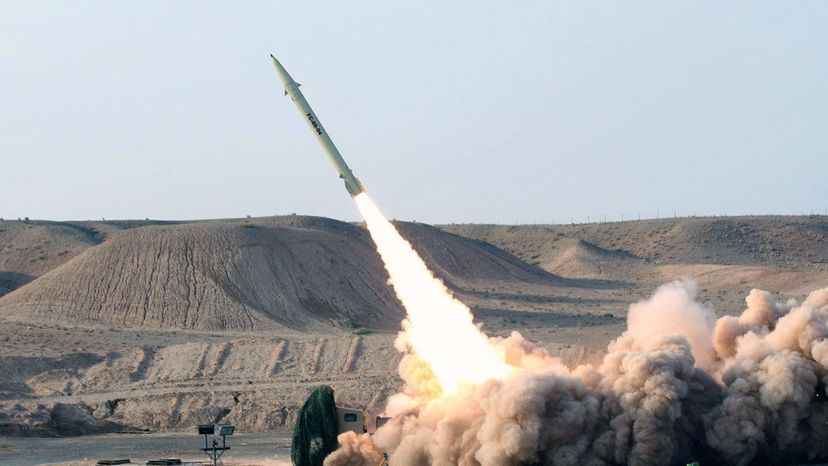
In 2017, North Korea unexpectedly staged a test launch of what was then a new ballistic missile , the Pukguksong-2. The launch took place when Japanese Prime Minister Shinzo Abe was on a state visit to the United States . There have been many more test launches of ballistic missiles by North Korea since. Between May and October 2019, North Korea launched as many as 12 ballistic missiles or other projectiles. But they have all been just test launches.
Things got real, though, on Jan. 7, 2020, when Iran launched more than a dozen ballistic missiles at two Iraqi military bases housing U.S. troops. This was not a test launch. It was Iran's retaliation for the U.S. drone strike that killed Iran Gen. Qassem Soleimani on Jan. 3, 2020. There were no casualties and Iran's Foreign Minister Mohammad Javad Zarif defended the missile strike on the U.S. bases in Iraq, saying it was an act of "self-defense."
But for the non-military minded among us, these ballistic missile launches — both the constant test launches in North Korea and the intentional strikes on U.S. bases in Iraq — may raise a good question: What exactly is a ballistic missile, anyway? Is there something about the ballistic part that makes a missile even more dangerous? After all, when someone freaks out we say they've "gone ballistic."
According to the Federation of American Scientists , a ballistic missile is one that has a ballistic trajectory over most of its flight path. What that means is that once the missile burns up the fuel that propels it, the missile keeps moving, the same way that a bullet does after it's been fired out of a gun. Once the fuel is gone, the missile's direction can't be altered. It follows a path determined by the speed of its launch and the force of gravity trying to pull it back toward the Earth's surface. Eventually, gravity guides the missile — and its payload, which might be an explosive, a chemical or biological weapon, or a nuclear device — down toward its target.
Ballistic missiles are different than cruise missiles. Cruise missiles are self-propelled for the majority of their time in the air, flying in a relatively straight line and at lower altitudes thanks to a rocket propellant. Think of a ballistic missile's flight path as a large arc up and back down again, while that of a cruise missile — fired from a warship, for instance — is closer to a straight line.
Ballistic missiles first came into use during World War II, when the Germans used a ballistic missile called the V-2 to attack London. British air defenses designed to stop aircraft couldn't stop the V-2s, because the rockets traveled too high into the upper atmosphere and moved too fast.
After the war, the U.S., with the help of captured German technology and scientists, built its own arsenal of even more powerful intercontinental ballistic missiles (ICBMs) capable of unleashing nuclear destruction upon targets on the other side of the world. The Soviet Union and China built ICBMs as well, setting up a world where a nuclear war was deterred by the prospect of mutual assured destruction.
The North Korean regime successfully tested intercontinental ballistic missiles (ICBM) in July and November 2017. Its Hwasong-15 ICBM reached an altitude of 2,780 miles (4,475 kilometers) and flew about 590 miles (1,000 kilometers) before landing in the sea off the coast of Japan. Analysts estimate the Hwasong-15 has a potential range of 8,100 miles (13,000 kilometers). If it's fired on a flatter trajectory, it could reach potentially reach anywhere on the U.S. mainland.
Which countries have intercontinental ballistic missiles?
What is meant by ballistic trajectory, what is difference between a ballistic and a cruise missile, how high do ballistic missiles fly, are ballistic missiles nuclear.
Please copy/paste the following text to properly cite this HowStuffWorks.com article:

- Mission Statement
- Advisors to the Board
- Military Fellows
- Jobs at MDAA
- Arizona AETOS ’25
- University of Hawaii Space Science Initiative
- USC SHIELD ’24
- USC SHIELD ’23
- USC SHIELD ’22
- USC SHIELD Alerts
- USC SHIELD in the News
- 2024 European Missile Defender of the Year and Regional IAMD Coalitions Conference
- Ronald Reagan Missile Defense Site, Vandenberg SFB
- Kauai Veteran’s Eternal Memorial and Missile Defense Viewing Site
- Lessons Learned Series
- Write Your Representative
- April 12th, 2022 U.S. Missile Defense – An Overview of Past, Current, and Future Roles and Responsibilities
- Virtual CRT: U.S. Missile Defense – An Overview of Past, Current, and Future Roles and Responsibilities
- MDAA Alert: The Roles and Responsibilities of Missile Defense
- Threat News
- Missile Defense News
- Air Defense News
- MDAA in the News
- Threat Basics
- Ukrainian War Updates
- Taiwan Incursion Updates
- Global Missile Tracker
- Space Threats Updates
- Notable Missile Tests
- Combat Launches
- Future Missile Threats
- U.S. Missile Defense
- Missile Defense of U.S. Partners
- Missile Defense Intercept Test Record
- Operational Intercepts by System
- Future BMD Systems
- Discontinued Programs
- U.S. Air Defense
- Air Defense of U.S. Partners
- Future Air Defense Systems
- Alerts Archive
- MDAA U.S. Ballistic Missile Defense Overview
- MDAA System/Issue Briefs
- MDAA Country Briefs
- Foreign Military Sales by Country
- 3D Panoramas
- Additional Resources
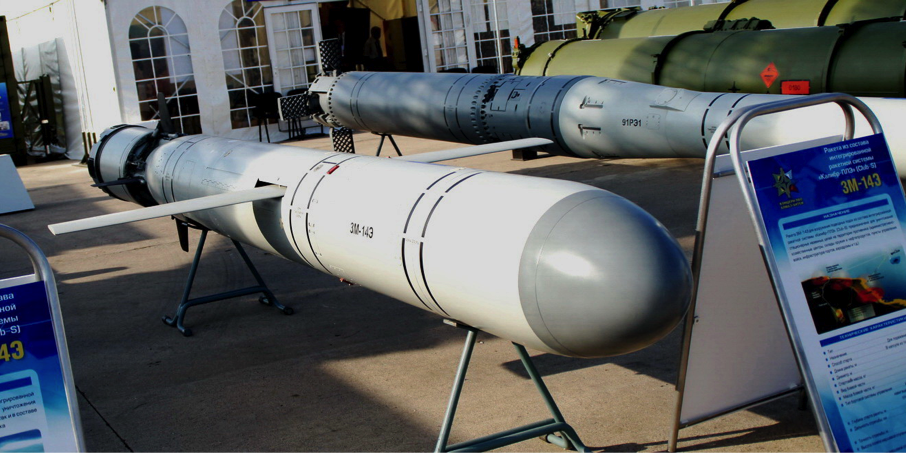
- Cruise Missile Basics
What is a cruise missile?
Cruise missiles, although similar to ballistic missiles in some regards, provide an alternate means to deliver a lethal payload rapidly and accurately to a target. Cruise missiles differ from ballistic missiles in that they fly towards their target at lower altitudes, remaining within the Earth’s atmosphere throughout their trajectory. Cruise missiles are defined as “an unmanned self-propelled guided vehicle that sustains flight through aerodynamic lift for most of its flight path and whose primary mission is to place an ordnance or special payload on a target.” [1] Unmanned aerial vehicles (UAVs) and unmanned control-guided helicopters or aircraft can be included in this definition [2] , but will not be discussed on this page.
The cruise missile has its beginnings in World War I, when the U.S. Army developed the Kettering Bug, an unmanned aerial bomb designed to strike targets beyond the range of artillery and too dangerous for piloted aircraft. However, the Kettering Bug was never used in combat. [3] Instead, the modern cruise missile originates more from the V-1 Flying Bomb used by the Germany in the last months of World War II. [4]
Launch Platforms
Cruise missiles are capable of being launched from multiple ground, air, sea and submarine platforms. Both fighter and long-range bomber aircraft are capable of carrying and launching cruise missiles. [5] On the ground, cruise missiles are most commonly launched by road-mobile systems due to the inherent advantages of mobility, but they can also be launched from fixed platforms. [6]
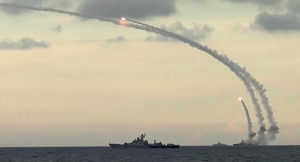
Russian warships in the Caspian Sea launch Kalibr cruise missiles towards targets inside Syria.
At sea, various surface ships and submarines can launch cruise missiles. Submarines are capable of launching while surfaced or submerged using torpedo fixtures or vertical launch tubes. [7] In April 2010 Kontsern-Morinformsistema-Agat, a Russian company, began marketing a version of the Russian Kalibr cruise missile housed in and capable of being launched from a standard shipping container. [8] This would allow any vehicle capable of carrying a standard shipping container to become a discreet platform from which to launch cruise missiles. [9]
Propulsion and Flight
Cruise missiles utilize jet engines as their primary method of propulsion. Most cruise missiles are subsonic and use Turbofan and Turbojet engines. While less common, supersonic and hypersonic cruise missiles utilize Ramjet and Scramjet engines. [10] Some also use rocket motor propulsion as a booster in the first phase of flight [11] or to accelerate to supersonic speeds in the terminal phase. [12]
Cruise missiles can fly to their targets at varying altitudes as long as they remain within the atmosphere. The trajectory of most remains close to the Earth’s surface, sometimes skimming just meters above the ground. Their low flight path makes it much harder for most radar and sensor systems to detect the missile, unless the radar or sensor system is airborne and directed towards the ground. [13] Some cruise missiles will fly only at high altitudes and dive sharply down once they reach their target. Flying at high altitude can extend the range of the missile because it’s more fuel-efficient than flying at lower altitudes. However, this also makes the missile more susceptible to missile defense systems since today’s radars and sensors are typically positioned to detect and track high altitude threats. [14] Cruise missiles can also mix their flight trajectory between high and low altitude in order to get the benefits of both. In this instance, cruise missiles will typically fly at a high altitude early in their flight to help extend their range, but as they approach their target, or missile defenses, they will fly down to a lower sea skimming/terrain hugging altitude to help it evade detection and defenses. [15]
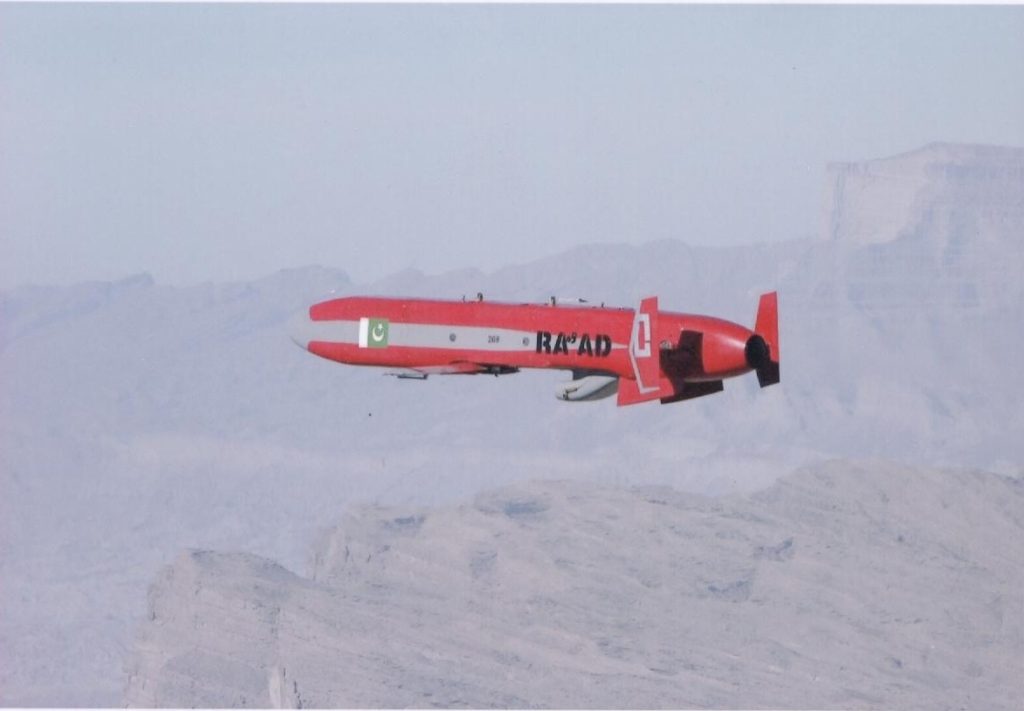
Flight test of Pakistan’s Ra’ad cruise missile.
Cruise missiles can use multiple guidance methods in order to accurately place their ordinance on the desired target and avoid missile defense systems. One of the first methods used by cruise missiles was inertial guidance, which is still used today and allows the missile to fly along a flight path programmed prior to launch. [16] Another guidance method is terrain contour matching (TERCOM), which compares a terrain map to the current terrain the missile is flying over to ensure the missile is flying on the correct path. [17] Some use GPS systems, which require connection to either GPS or GLONASS satellite system, but can help ensure the missile follows the correct flight path and strikes the final target using specific coordinates with a high degree of accuracy. [18]
Other guidance methods are primarily used in the terminal phase of flight to increase accuracy. One is a laser guided system which uses a sensor to detect its target painted by a laser, however this can be unreliable because dust and smoke can interfere with the laser or the missile may not always be able to see the laser or painted target. [19] Another terminal guidance method is TV guidance, in which an operator uses a camera in the nose of the missile to visually identify and manually guide the missile to the target in its final phase. This method also gives the operator the option to abort the strike in the final phase if an anomaly is detected. [20] A radar seeker is also used in the nose of some missiles to identify and/or keep the missile on target in the terminal phase. These radar seekers use either passive radar, which detect radar emissions of their target, or active radar, which emit their own radar to detect their target. [21] Infrared (IR) guidance – directing the missile towards heat emitting objects, such as engines [22] – may also be used by cruise missiles in the terminal phase. [23] However, because of its simplicity, IR guidance cannot differentiate between friendly, adversarial, or extraneous IR signals in a crowded battlefield, and is usually used in conjunction with other guidance systems. [24] The last guidance system used by cruise missiles is Digital Scene Matching Area Correlation (DSMAC), which uses a camera in the missile to find the desired target and match it to a stored image using an image correlator. [25]
Cruise missiles are typically armed with conventional or nuclear warheads, but can also be equipped with chemical or biological warheads. [26] The warhead weight and yield can vary widely, depending on the specific cruise missile and its mission.
[1] “Cruise Missiles.” Federation of American Scientists. http://fas.org/nuke/intro/cm/
[3] “Kettering Bug.” UAVGLOBAL. http://www.uavglobal.com/kettering-bug/ ; “War Machines: Cruise Missile.” National Geographic. https://www.youtube.com/watch?v=AD8Kr0f1tEY
[4] Hickman, Kennedy. “World War II: V-1 Flying Bomb.” About Education. http://militaryhistory.about.com/od/artillerysiegeweapons/p/v1.htm
[5] N.R.P. “Explained: How Cruise Missiles Work!” Defencyclopedia. https://defencyclopedia.com/2014/08/01/explained-how-cruise-missiles-work/
[8] Stott, Michael. “Deadly New Russian Weapon Hides in Shipping Container.” Reuters. http://www.reuters.com/article/us-russia-weapon-idUSTRE63P2XB20100426
[9] Lewis, Jeffrey, Nikolai Sokov. “Sokov on Russian Cruise Missiles.” Arms Control Wonk. http://www.armscontrolwonk.com/archive/207801/sokov-on-russian-cruise-missiles/
[11] Brain, Marshall. “How Cruise Missiles Work.” How Stuff Works. http://science.howstuffworks.com/cruise-missile.htm
[12] N.R.P. “Explained: How Cruise Missiles Work!” Defencyclopedia. https://defencyclopedia.com/2014/08/01/explained-how-cruise-missiles-work/
[22] Kopp, Carlo. “Heat-Seeking Missile Guidance.” Air Power Australia. http://ausairpower.net/TE-IR-Guidance.html
[23] N.R.P. “Explained: How Cruise Missiles Work!” Defencyclopedia. https://defencyclopedia.com/2014/08/01/explained-how-cruise-missiles-work/
[25] Brain, Marshall. “How Cruise Missiles Work.” How Stuff Works. http://science.howstuffworks.com/cruise-missile.htm
[26] “Ballistic and Cruise Missile Threat.” Federation of American Scientists. http://fas.org/irp/threat/missile/naic/part02.htm ; Norris, Robert S., Hans M. Kristensen. “Nuclear Cruise Missiles.” Bulletin of the Atomic Scientists. http://bos.sagepub.com/content/63/6/60.full
Missile Threat and Proliferation
- Missile Payload Destruction Cost Comparisons
- Technological Threat Assessment
- War By 2025 Threat Analysis
- Ballistic Missile Basics
- Hypersonic Weapon Basics
- Rocket and Mortar Basics
- Unmanned Aircraft System (UAS) Basics
- Non-State Actors
- Israel-Hamas War Updates
- United States Incursion Tracker
- World Drone Comparison
- Dong Feng-16 (CSS-11)
- Dong Feng-15 (CSS-6)
- Dong Feng-11 (CSS-7)
- M-7 (8610)/CSS-8
- Dong Feng-12 (CSS-X-15)
- Dong Feng-3 (CSS-2)
- Dong Feng-21 (CSS-5)
- Dong Feng-21D (CSS-5)
- Dong Feng-26
- Dong Feng-4 (CSS-3)
- Dong Feng-5 (DF-5)
- Dong Feng-31 (CSS-10)
- Dong Feng-41(CSS-X-20)
- DH-10 / CJ-10
- Changjian-20 (CJ-20)
- DF-ZF Hypersonic Glide Vehicle
- Dong Feng-17
- Chinese Spy Balloons
- Hwasong-17/KN-27
- Pukguksong-3 (KN-26)
- KN-02 (Toksa)
- Hwasong-5 (Scud-B Variant)
- Hwasong-6 (Scud-C Variant)
- Hwasong-9 (Scud-ER/Scud-D Variant)
- Polaris-2 (Pukguksong-2/KN-15)
- Taepodong-1
- Hwasong-12/KN-17
- Taepodong-2
- KN-08 / Hwasong-13
- Hwasong-14/KN-20
- Hwasong-15/KN-22
- 3M22 Zircon
- Avangard (Hypersonic Glide Vehicle)
- RS-26 Rubezh
- OTR-21 Tochka (SS-21 Scarab)
- SS-1 Scud-A
- R-17 Elbrus (SS-1 Scud-B)
- S-300P Air and Missile Defense System
- S-300V Air and Missile Defense System
- S-400 Triumf Air Defense System
- SS-1d Scud-C
- R-17 VTO/SS-1e (Scud-D)
- Iskander-M (SS-26)
- Kh-47M2 Kinzhal (“Dagger”)
- SS-18 Satan/R-36M2 Voyevoda
- SS-19 Stiletto
- RS-12M Topol (SS-25 Sickle)
- SS-27 / Topol-M
- SS-27 Mod 2 / RS-24 Yars
- RS-28 Sarmat (Satan 2)
- AS-15 Kent (Kh-55 Granat)
- RK-55 Relief (SS-N-21 Sampson)
- 3M-54 Klub (SS-N-27 Sizzler)
- 3M-14 Kalibr (SS-N-30A)
- P-15 Termit (SS-N-2 Styx)
- P-6 Progress/SS-N-3C Shaddock
- P-120 Malakhit (SS-N-9 Siren)
- P-270 Moskit/SS-N-22 Sunburn
- P-500 Bazalt (SS-N-12 Sandbox)
- P-700 Granit/SS-N-19 “Shipwreck”
- KH-35 (SS-N-25 Switchblade)
- P-800 Oniks (SS-N-26 Strobile)
- P-1000 Vulkan
- R-29R / SS-N-18 Stingray
- R-29RM / SS-N-23 Skiff
- SS-N-30 Bulava
- Tondar-69 (M7, CSS-8)
- Natanz Enrichment Facility
- Fordow Uranium Enrichment Plant
- Arak Heavy Water Nuclear Reactor
International Cooperation
Missile Defense Advocacy Alliance
515 King Street Suite 330 Alexandria VA, 22314 Phone: 703.299.0060 [email protected]
Quick Links
- Privacy Policy
© Missile Defense Advocacy Alliance 2024
Programs submenu
Regions submenu, topics submenu, poni 2024 capstone conference, dod's gaza pier and the maritime corridor—gaza: the human toll, lessons from myanmar.
- Abshire-Inamori Leadership Academy
- Aerospace Security Project
- Africa Program
- Americas Program
- Arleigh A. Burke Chair in Strategy
- Asia Maritime Transparency Initiative
- Asia Program
- Australia Chair
- Brzezinski Chair in Global Security and Geostrategy
- Brzezinski Institute on Geostrategy
- Chair in U.S.-India Policy Studies
- China Power Project
- Chinese Business and Economics
- Defending Democratic Institutions
- Defense-Industrial Initiatives Group
- Defense 360
- Defense Budget Analysis
- Diversity and Leadership in International Affairs Project
- Economics Program
- Emeritus Chair in Strategy
- Energy Security and Climate Change Program
- Europe, Russia, and Eurasia Program
- Freeman Chair in China Studies
- Futures Lab
- Geoeconomic Council of Advisers
- Global Food and Water Security Program
- Global Health Policy Center
- Hess Center for New Frontiers
- Human Rights Initiative
- Humanitarian Agenda
- Intelligence, National Security, and Technology Program
- International Security Program
- Japan Chair
- Kissinger Chair
- Korea Chair
- Langone Chair in American Leadership
- Middle East Program
- Missile Defense Project
- Project on Critical Minerals Security
- Project on Fragility and Mobility
- Project on Nuclear Issues
- Project on Prosperity and Development
- Project on Trade and Technology
- Renewing American Innovation Project
- Scholl Chair in International Business
- Smart Women, Smart Power
- Southeast Asia Program
- Stephenson Ocean Security Project
- Strategic Technologies Program
- Transnational Threats Project
- Wadhwani Center for AI and Advanced Technologies
- All Regions
- Australia, New Zealand & Pacific
- Middle East
- Russia and Eurasia
- American Innovation
- Civic Education
- Climate Change
- Cybersecurity
- Defense Budget and Acquisition
- Defense and Security
- Energy and Sustainability
- Food Security
- Gender and International Security
- Geopolitics
- Global Health
- Human Rights
- Humanitarian Assistance
- Intelligence
- International Development
- Maritime Issues and Oceans
- Missile Defense
- Nuclear Issues
- Transnational Threats
- Water Security
The 2022 Missile Defense Review: Still Seeking Alignment

Commentary by Tom Karako
Published October 27, 2022
The Biden administration released its unclassified Missile Defense Review today, as part of the National Defense Strategy. As policy guidance to an increasingly broad enterprise, the 2022 MDR represents an opportunity to achieve greater alignment between U.S. air and missile defense (AMD) efforts and the strategic competition with China and Russia.
The new MDR is a step forward from past reviews in several respects. Gone is the primary focus on rogue state ballistic missiles that defined the 2010 review. It also corrects the 2019 MDR’s insufficient attention to integration, air defense layering for cruise missile and UAS threats, and survivability. Although the public version of the review leaves much to be desired, it nevertheless advances several critical mission areas: a comprehensive approach to missile defeat, homeland cruise missile defense, the defense of Guam, and distributed operations.
This MDR has three parts: the first addresses the evolving air and missile threat environment, the second, the U.S. strategy and policy framework, and the third, ways to strengthen international cooperation. Following the overarching theme of the 2022 NDS, the MDR describes missile defenses as a critical component of “integrated deterrence,” defined as a framework bringing together all instruments of national power.
The 12-page, 4,700-word document is dramatically shorter than the 2019 version, which came in at 28,834 words and 100 pages. While brevity can bring readability and concision, it can do so at the expense of what is unsaid and of questions left open.
Despite the National Defense Strategy’s emphasis on this as the “decisive decade,” the MDR does not specify dates or timelines, and budget documents suggest that key new capabilities appear to be pushed to the 2030s. Other notable absences include the usual reference to arms control limitations, the need for increasing production quantities, the need for maintaining flexible acquisition authorities, and specifics on who exactly will manage this new “missile defeat” enterprise.
Weapons of Choice
One of the strengths of the 2019 MDR was its broader description of missile threats, to include ballistic, cruise, and hypersonic missiles. The Trump administration’s actual programmatic and budgetary implementation of hypersonic and cruise missile defense, however, were quite modest. The 2019 review also neglected UAS as a species of air defense, or what the new review calls “missile-related” threats. As seen in the Nagorno-Karabakh conflict, Iranian attacks in 2019 , and the Ukrainian war this year, that neglect is no longer tenable.
The 2022 review draws attention to the more complete spectrum of air and missile threats. It describes UAS as an “inexpensive, flexible, and plausibly deniable” means to “carry out tactical-level attacks below the threshold for major response, making them an increasingly preferred capability.” Still, other delivery systems must also be contemplated going forward, including spaceplanes and fractional or multiple orbital delivery systems “that move in and out of the atmosphere.”
The threat description in the MDR is, however, less sharply put than that conveyed by the May 2022 congressional testimony of Assistant Secretary of Defense John Plumb: “Offensive missiles are increasingly weapons of choice for Russia, China, North Korea, and Iran, for use in conflict and to coerce and intimidate their neighbors.”
Strategic Deterrence and Defense
Like the Obama and Trump administration reviews, the Biden MDR notes that "the United States will continue to rely on strategic deterrence . . . to address and deter large intercontinental-range, nuclear missile threats to the homeland.” While this distinction may apply specifically to Chinese and Russian intercontinental ballistic missiles, it need not apply to other delivery systems, to non-nuclear strategic attack, or to the likes of North Korea.
Even as threats increase, the new MDR states “the United States will also continue to stay ahead of North Korean missile threats to the homeland through a comprehensive missile defeat approach, complemented by the credible threat of direct cost imposition through nuclear and non-nuclear means.” The use of “missile defeat” represents a subtle but important shift which applies broadly to the missile defense enterprise. A broad defense and defeat-dominant posture toward North Korea remains intact, but attack operations and more novel measures left of launch will help size the requirements for active missile defense interceptors within the comprehensive missile defeat enterprise.
Homeland ballistic missile defense is here to stay. The Ground-based Midcourse Defense (GMD) system is “an essential element” of missile defeat, and its “continued modernization and expansion” is necessary to maintain both “a visible measure of protection for the U.S. population” and an assurance to “allies and partners that the United States will not be coerced by threats to the homeland.” The Biden administration initiated a competitive development process to procure 20 Next Generation Interceptors (NGIs) in March 2021. The MDR notes that the NGI may not merely “augment” but “potentially replace” today’s fleet of 44 Ground Based Interceptors.
Air Defenses
The 2022 MDR corrects past inattention to aerial threats, including unmanned aerial systems (UAS) and homeland cruise missile defense. The review says that “homeland and regionally forward deployed forces require the fielding of technical and integrated C-UAS solutions.” While not discussed in the review, the U.S. Army is moving out rapidly as the acquisition authority for countering UAS (C-UAS). Possible capability improvements are legion, but capacity and training for the mission remain paramount. The new MDR likewise embraces cruise missile defense for the homeland (CMD-H), which first appeared in the 2022 and 2023 budget requests. The past focus on rogue state ballistic missile attacks should give way to a focus on a nonnuclear strategic attack by major powers: “To deter attempts by adversaries to stay under the nuclear threshold and achieve strategic results with conventional capabilities, the United States will examine active and passive defense measures to decrease the risk from any cruise missile strike against critical assets, regardless of origin.”
The discussion of future technologies prioritizes sensors above all, followed by battle management and command and control (C2). The missions for AMD sensors are to “detect, characterize, track, and engage current and emerging advanced air and missile threats regionally, and to improve early warning, identification, tracking, discrimination, and attribution for missile threats to the homeland.” Requiring engagement support for regional threats but not for attacks on the homeland seems especially odd since the document repeatedly highlights the specter of nonnuclear strategic attack on the homeland. CMD-H must also include engagement capabilities; its sensors must include those capable of combat identification and fire control quality tracks. That paragraph highlights modern over-the-horizon radars for “improving warning and tracking against cruise missile and other threats to the homeland.” The same criterion must be applied to the emerging space sensors. It is not good enough to provide “strategic and theater missile warning and tracking.” Sensor architectures must also support fire control.
The 2019 review referenced “transregional” threats, which blur the legacy distinction between homeland and regional concerns. As it turns out, cruise missiles, UAS, and aerial threats that threaten U.S. forces and allies in other regions are a global concern. North America is a region, too, and cruise missile defense for the homeland is a capability the United States has neglected for too long. Embracing the priority of homeland missile defense requires attention to more than just rogue state ballistic missiles. It remains to be seen whether the Air Force moves out to field not just sensors but active defenses for CMD-H.
Complex and Integrated Attacks
The new MDR notably recognizes how various air and missile threats would be used in conjunction for complex and integrated attacks. The text places special attention to UAS: “Adversaries also are utilizing multiple types of missile salvos—such as one-way attack UAS in combination with rockets—in an effort to defeat missile defense systems.” America’s perceived birthright to air superiority is long gone. Recognition in a policy document of how adversary air and missile threats could suppress and disintegrate active defenses is long overdue. Its implications are profound.
It is critical to acknowledge that adversaries will attempt to suppress U.S. and allied AMD capabilities. The 2018 NDS endorsed dispersed basing and operations, but the 2019 MDR did not apply that logic to AMD. The 2022 review does so explicitly: “Future air and missile defense capabilities must also be more mobile, flexible, survivable, and affordable, and emphasize disaggregation, dispersal, and maneuver to mitigate the threat from adversary missiles.”
AMD is necessary not only for fixed infrastructure, but for “joint maneuver forces.” It is all well and good to move swiftly around the battlefield, but loitering munitions and cruise missile targeting has dramatically improved. Mobility is no longer a panacea. With limited room to move on a small island like Guam—where launchers have little place to be repositioned—it may not be worth the time and expense to require AMD elements to be fully mobile. When one must defend what one cannot move or hide, fixed emplacements may be good enough.
The defense of Guam is, indeed, one of the most important new initiatives of the Biden administration. Despite years of urging by U.S. Indo-Pacific Command, the matter only first appeared in the 2022 and 2023 budget requests. As with CMD-H, the problem of Guam further defies the homeland-regional dichotomy of yesteryear. Guam has a “unique status as both an unequivocal part of the United States as well as a vital regional location.” The significance of Guam as a test case for full-spectrum, 360-degree AMD cannot be overstated.
International Cooperation
Three of the MDR’s 12 pages are devoted to describing international missile defense cooperation. Its discussion of cooperation with Canada is accompanied by reference to the “acute” (read: Russian) threat of “increasingly sophisticated conventional missile capabilities that are able to target critical infrastructure in North America.” Again, the document commits to improving “early warning surveillance for potential incursions or attacks,” but does not discuss the need for fire-control quality tracking and engagement support.
In the Indo-Pacific, the MDR highlights cooperation with Japan, Australia, and South Korea. Within NATO, the Patriot, NASAMS, and the SAMP-T systems get shoutouts in the endorsement of 360-degree AMD (read: to include Russia). The European Sky Shield Initiative may be an important element of this, although C2 and sensors for NATO probably deserve prioritization. Recent developments in Europe include Germany’s consideration of Arrow-3, Poland’s defense buildup across the board, and Finland and Sweden’s likely accession to NATO. Slovakia, moreover, likely needs new defenses to replace the S-300 units it donated to Ukraine. The document recognizes the longstanding cooperative efforts with Israel, encourages Gulf Cooperation Council cooperation, and notes the “ongoing normalization efforts between Israel and key Arab states” to create new opportunities for AMD cooperation.
The global market for AMD capabilities has continued to increase. The MDR notes how Russia uses “several lower-tier air defense systems for its own use and export as a foreign policy instrument.” The sale of the S-400 to countries like Turkey and India, for instance, has certainly been a wedge within the alliances. How well Russia is able to maintain the operation and upgrades of those exports in the face of sanctions on its defense industry will remain to be seen.
Honorable Unmentions
The brevity of the 2022 review means that it leaves several issues unmentioned. One notable absence is timelines and phases. It is one thing to say that the United States must defend Guam, that it must have hypersonic defense, and that space sensors are critical, but there are no express milestones or dates to assess whether they will be available within the decade, let alone at the speed of relevance.
Also missing are the usual recitations about arms control. The 2010 review declared that “the Administration will continue to reject any negotiated restraints on U.S. ballistic missile defenses,” and the 2019 review affirmed that “the United States will not accept any limitation or constraint on the development or deployment of missile defense capabilities needed to protect the homeland against rogue missile threats.” Instead, with language reminiscent of the 1972 Anti-Ballistic Missile Treaty’s preamble, the document highlights “the interrelationship between strategic offensive arms and strategic defensive systems.” Without endorsing limitations, the 2022 MDR suggests “strengthening mutual transparency and predictability.”
Another omission is any reference to acquisition authorities, the protection of which was affirmed in both the 2010 and 2019 reviews and in numerous legislative pronouncements. This may reflect the legacy of what is known as the “Trump DTM,” the Directive Type Memorandum . Even when the Pentagon was pushing acquisition authorities down across the services, the Trump administration began to undermine the acquisition authorities of the Missile Defense Agency. The 2022 MDR does, however, acknowledge the need for “adaptive acquisition approaches.” Rescinding the Trump DTM would help protect such approaches.
The document omits past discussions on directed-energy missile defense systems. Given the intensity of the air and missile threat spectrum, non-kinetic effects offer considerable promise. The Trump administration removed directed energy from the Missile Defense Agency’s budget. As technology has advanced in service and DOD-wide applications, concepts like high-powered microwaves, short-pulse lasers, and other types might now have applications for active defense missions.
The MDR’s policy direction does not seem to address who will manage the department’s missile defeat enterprise. While embracing of the full means of countering and defeating missile threats has much to commend it, an unbalanced pivot to “missile defeat” carries could have pitfalls. A prudent “fly before you buy” approach should apply to exotic non-kinetic and left-of-launch capabilities just as it does to hit-to-kill interceptors. Reliance on highly secret solutions that sacrifices deterrence for warfighting may be necessary, but nonkinetic and left-of-launch capabilities could be unproven, untestable, incapable of demonstration, and unsusceptible to foreign military sales.
A final unmentioned item worthy of policy guidance relates to production. One of the many lessons of the Ukraine conflict is how quickly missiles and munitions are expended in a conflict with a major power. The necessity of mass-producing AMD elements must be addressed. European countries who have given their air defenses to Ukraine, for instance, will no doubt be expecting a backfill. NATO’s air defense initiatives signal a demand for significant procurement and the potential for collaborative and bulk approaches.
As Assistant Secretary Plumb said in May , “Missiles have become a common and expected facet of modern warfare,” which makes “missile defeat and missile defense efforts more important than ever.” If the Trump MDR foundered for disconnects from budgets and programs, the Biden MDR deserves similar scrutiny so that these capabilities do not remain paper programs . While advancing certain mission areas on paper, taking the next steps requires implementing CMD-H, the defense of Guam, space sensors, and hypersonic defense with the seriousness they demand. The missile threat spectrum is not a boutique problem, but a central military challenge from China and Russia. Whether the Biden administration will properly resource and implement the goals of its MDR and NDS is now the question.
Tom Karako is a senior fellow with the International Security Program and the director of the Missile Defense Project at the Center for Strategic and International Studies in Washington, D.C.
Commentary is produced by the Center for Strategic and International Studies (CSIS), a private, tax-exempt institution focusing on international public policy issues. Its research is nonpartisan and nonproprietary. CSIS does not take specific policy positions. Accordingly, all views, positions, and conclusions expressed in this publication should be understood to be solely those of the author(s).
© 2022 by the Center for Strategic and International Studies. All rights reserved.

Programs & Projects
BrahMos: Everything you need to know about the cruise missile system
Defence iq talks to the jv’s general manager and marketing director praveen pathak on brahmos' current status and future plans..

Chasing the world’s fastest jet-launched cruise missile

BRAHMOS BrahMos first drop and launch from a Su-30 MK I
Defence IQ : Typically, a weapon of eight metres in length and close to three tons in weight is typically carried by bombers like the B-1B or Tu-160. This makes the Sukhoi Su-30MK very unique as it is able to carry the BrahMos… P. Pathak : Yes, this is only possible with a unique platform like the Indian Sukhois, itself a class of its own among the fighters. BrahMos is a huge achievement of Russian- Indian military and technical cooperation. These successful achievements from India’s DRDO. Defence Research & Development Organisation] and Russia’s Mashinostroyenia have spread progress and innovation across facilities in both nations. Defence IQ : After several years, tests and trials, can you tell us about the journey to where you currently are with the project? P. Pathak : I’ll start with a brief history. The missile was jointly developed in the late 1990s and 2000s by the Research & Production Association of Machine-Building [in the town of Reutov near Moscow] and our DRDO, thanks to an agreement between the governments of Russia and India, signed on February 12, 1998. BrahMos is a modification of Sovietera anti-ship missiles [Oniks, Yakont] developed by the Reutov Design Bureau in the late 1980s. The name derived from India’s Brahmaputra and Russia’s Moskva rivers. The first test launch was conducted on June 12, 2001, at the Chandipur range in Odisha, India, and subsequently, the missiles began production at enterprises in both countries. Development of these cruise missiles is a natural progression for India, in seeking to develop various platforms for its military arsenal, either on its own or with a partner – but nevertheless, in India. BrahMos is technically a ramjetpowered supersonic cruise missile with a solid propellant booster that can be launched from land-based canisters, submarines, ships and now aircraft. It travels at speeds of Mach 2.8 to 3.0 but is being upgraded in the future to travel at speeds faster than Mach 5.0. for the hypersonic variant.
"BrahMos is technically a ramjet-powered supersonic cruise missile with a solid propellant booster"

BRAHMOS Brahmos has been fired successfully from Indian submarines
Defence IQ : An Indian pilot in Bahrain stated that the latest developments have been particularly challenging and lengthy. Is that the experience you’ve had? P. Pathak : He’s right! Integration efforts onto the flying platform were very complex involving mechanical, electrical and software modifications of the aircraft. The Indian Air Force [IAF] was involved in the development process, as software development of the aircraft was undertaken by the IAF engineers. HAL [state-run Hindustan Aircraft Ltd.] carried out the mechanical and electrical modifications on the aircraft. In addition, the air-launched variant had to be made 500 kg lighter than the land/naval variants. One of the major challenges DRDO scientists had to overcome was the optimisation of transfer-alignment inertial sensors. Thankfully, the experience of the IAF flight test crew and the dedicated and synergetic efforts of the IAF, DRDO and HAL ensured that the integration was smooth. Altogether, it has proven India’s ability to undertake such complex integrations on its own.
"One of the major challenges DRDO scientists had to overcome was the optimisation of transferalignment inertial sensors"
Defence IQ : What tests were undertaken before serial production? P. Pathak : Serial production has been ongoing for the Army and Navy for more than 10 years. Regarding the air variant of BrahMos, there are two important dates. In June 2016, two test-pilots of the ASTE [Aircraft and Systems Testing Establishment, a premier IAF, at Bengaluru] carried out the first flights and carriage-tests with a full weight test-vehicle of BrahMos on a Su-30MKI. RECOMMENDED: How capable is the S-400 missile system? And in November 2017, the IAF successfully fired the BrahMos-A in an anti-shipping configuration from the same frontline fighter aircraft, off the Eastern Coast in the Bay of Bengal. The launch was smooth; it fell for about 100 to 150 metres, ignited and followed the desired trajectory, before directly hitting the target ship. This only succeeded with dedicated support from the Indian Navy, by way of ensuring availability of the targets and a large number of monitoring ships to ensure data collection and range safety clearance. Defence IQ : Excellent! Can you tell us about the accuracy of the 3-tonne missiles? P. Pathak : Recently, a final phase steep dive test of the missile was conducted and it proved to have landed within a range of 10 metres of the targeted area, fired over a range of almost 300 km. Defence IQ : Impressive! With regards to ranges, there was a report that BrahMos now benefits from India’s access to the 34-nation Missile Technology Control Regime. Is this the case? P. Pathak: Yes. In June 2016 India was bound by restrictions that limited the range of the operational missile to less than 300km. We had already experimented with the range from 290km to 400km and then successfully first testfired a variant in March 2017. But, increasing the missile’s range from 400km to a further 800km is now possible after India’s induction into the MTCR. And that is being considered…
"The IAF wants two Squadrons of Su-30 MKIs to be modified to accommodate BrahMos, but HAL is proposing to build new aircraft"

BRAHMOS A Brahmos missile on a HAL Tejas fighter
Defence IQ : Interesting! What can you tell us about the current versions employed by the Army and Navy? P. Pathak : Currently, the Army is equipped with three regiments of Block-III BrahMos, with two fully operational. Last year there was a successful test-firing from a test range at Chandipur along the Odisha coast, to validate some new features like an indigenous Indian seeker. It was to conduct and validate life extension technologies, developed for the first time in India. Our Minister of Defence, Nirmala Sitharaman, congratulated the DRDO scientists for the successful launch with new technology. RECOMMENDED: The future of artillery and long range missile systems: Industry outlook This will result in huge savings in replacement missiles already in the inventory of Indian Forces. Regarding the Navy, induction of the first version of the missile system in the Indian Navy began on [destroyer] INS Rajput, back in in 2005. After two successful test trials from INS Kolkata in June 2014 and February 2015 and a test firing from INS Kochi in September 2015, the newly commissioned ship’s systems were validated. Additionally, we’re starting to see good results incorporating BrahMos into submarines with the first firings from a submerged platform having already taken place. Defence IQ : The two surface ships you mentioned – are they carrying BrahMos in launchers or vertically? P. Pathak : In both, actually. There are older vessels that carry them in side-launchers [INS Ranvir D54, a ‘Kashin’ Class Destroyer Project 61ME], but some have been fitted with a module of the ‘Universal Vertical Launcher’, which is very state-of-the-art. Last October, the Cabinet Committee on Security [through which all Indian defence procurement has to be approved by Prime Minister N. Modi], has cleared the procurement of four Krivak-class frigates from Russia. These will be BrahMos-armed in vertical launchers, two to be built in a Russian shipyard [at Yantar in Kaliningrad], and the other two in India [Goa Shipyard Ltd.]. Defence IQ : And what about the future? At AERO-INDIA there was a blue NG [Next Generation] version shown, under the much smaller LCA [light combat aircraft] Tejas fighter. Is that likely to appear soon? P. Pathak : Quite a lot of planning is ongoing right now. BrahMos- Aerospace is actually working on several future versions, which shouldn’t be confused. A smaller version of the missile, termed Mini BrahMos, will be half the weight of the present missile but with more speed. This is part of independent research by the company to explore if a missile with smaller size can be as effective. Then there is – or will come – BrahMos NG , the latest development that will be launched from submarine torpedo-tubes, and the NG-A, launching also from the Su-30MKI as well as from the LCA Tejas and MiG-29s. A big difference is that, on the Sukhoi, up to five BrahMos-NG missiles could be carried, with two missiles on each wing and one under the fuselage. The MiG-29 and the LCA would carry two. The digitized NG means it comes with a digital fuel injection system that will increase thrust, unlike the current versions that have a mechanical fuel injection system. It also will be even faster, up to Mach 3.5. Defence IQ : So it will be smaller, but will retain the same range? P. Pathak : Yes. BrahMos-NG will have same 290 km range, but it will weigh around 1.5 tons and be 5 meters in length and 50 cm in diameter, making it 50% lighter and three meters shorter than its predecessor. However, having a smaller radar cross-section makes it super fast and harder to detect by anti-missile systems. Defence IQ : Which means it can use smaller platforms and lighter vehicles? P. Pathak : The land variant of the NG missile will be hosted on 8x8 launch vehicles, unlike the older version which used 12x12 launch vehicles. We had earlier designed it for the Navy, but this time it could also develop into an air-to-air version, against slow manoeuvring force multipliers, deep within enemy territory. Defence IQ : Could it serve as an air-to-air AWACS killer even after being fired from the Indian side of the border? Similarly, one supposes it could target enemy refuelling aircraft or transports… P. Pathak : That is within the scope of the system and the engineers are quoting it as quite possible. Defence IQ : What is the current timeframe projected? P. Pathak : A first test firing of the sleeker, lighter NG version could take place within two years, with feasibility studies showing the way forward to integrate it onto the LCA. They have found what modifications need to be done to the LCA’s wing to carry the NG, as well as some changes to the missile. RECOMMENDED: How the APKWS is improving the Hydra-70: BAE Systems interview Full integration, which we think can be expected within four years, will also boost the export potential of the fighter jet, as it would resemble a potent indigenous weapon system that can take down land targets or ships at a distance of almost 300 km.
"Research and development are already on their path to developing the hypersonic variant, called BrahMos II"
Defence IQ : And what about the hypersonic capability? P. Pathak : Research and development are already on their path to developing the hypersonic variant, called BrahMos II. It is projected to double the speed of the current BrahMos, potentially up to Mach 7. Defence IQ : And that will also be named the ‘BrahMos ER’? P. Pathak : The abbreviation ‘ER’ refers to the extended-range version up to 800 km, but not the hypersonic BrahMos-II, which goes even further. We calculate that an 800 km version might be ready for testing by end of this year.
Upcoming Events
Future artillery.
21 - 23 May, 2024 Novotel Paris Centre Tour Eiffel

Space Operations Summit
22 - 23 May, 2024 Copthorne Tara Hotel, London, UK

Surface, Air and Seabed Warfare
18 - 19 June, 2024 Portsmouth Marriott Hotel, UK

Full Spectrum Air Defence
24 - 27 June, 2024 Hilton Syon Park, London

Defence Transformation
24 - 26 September 2024 Hilton London Syon Park, London, UK

Countering Explosive Threat & Demining
24 - 25 September, 2024 Copthorne Tara Hotel London Kensington, London, United Kingdom

Subscribe to our Free Newsletter
Insights from the world’s foremost thought leaders delivered to your inbox.
Latest Webinars
Why does the ecological transition matter for military vehicle manufacturers.
2022-10-25 09:00 AM - 10:00 AM BST

Securing the Defence Industrial Base: Mitigating Risk and Delivering Resiliency in Physical and Digital Supply Chains
2022-04-21 12:00 PM - 01:00 PM EST

Zero Trust and Air Force Missions
2021-07-27 11:50 PM - 01:30 PM EDT

RECOMMENDED

FIND CONTENT BY TYPE
- Conferences
- Market Reports
- Whitepapers
- Post-Show Reports
Defence IQ COMMUNITY
- Events Calendar
- Authors & Submission Guide
- User Agreement
- Cookie Policy
ADVERTISE WITH US
Reach Defence professionals through cost-effective marketing opportunities to deliver your message, position yourself as a thought leader, and introduce new products, techniques and strategies to the market.
JOIN THE Defence IQ COMMUNITY
Join Defence IQ today and interact with a vibrant network of professionals, keeping up to date with the industry by accessing our wealth of articles, videos, live conferences and more.

Contact Us | About Us
Become a Member today!
PLEASE ENTER YOUR EMAIL TO JOIN FOR FREE
Already an IQPC Community Member? Sign in Here or Forgot Password Sign up now and get FREE access to our extensive library of reports, infographics, whitepapers, webinars and online events from the world’s foremost thought leaders.
We respect your privacy, by clicking 'Subscribe' you will receive our e-newsletter, including information on Podcasts, Webinars, event discounts, online learning opportunities and agree to our User Agreement. You have the right to object. For further information on how we process and monitor your personal data click here . You can unsubscribe at any time.
おトクにキレイになる情報が満載!
- 【ためるチャレンジ】ボーナスコインGET N
- 【スタンプカード】毎日押して大量コイン☆ N
- 【プレゼント】コインが当たる! N
- 【すごろく】1位で必ず1万円分のコイン★ N
navalpost.com
- 7,235円(税込)以上の お買い物で送料無料
- シャツ/ブラウス(長袖/七分)
メンテナンスのお知らせ | 新お買い物特典プログラム

レディースLE CIEL BLEU ルシェルブルー セットアップ ブラック
※ 商品のお届けについては こちら よりご確認ください。
SHOPPING が販売、発送いたします。
当日発送可 (14:00までのご注文が対象)
- ※ ご注文内容・出荷状況によっては当日発送できない場合もございます。 詳しくは こちら よりご確認ください。
- ※ ポストにお届け / 一点のみ購入でご利用可能です。 ゆうパケットでのお届けの場合はサンプル・ノベルティが対象外となります。 ゆうパケットには破損・紛失の保証はございません。 詳しくは こちら よりご確認ください。

- トップスの商品一覧を見る
- レディースの商品一覧を見る

clane クラネ フリンジボレロレディース
LE CIEL BLEU

ドレス値下げしました!M'SGRACY♡新品未使用黒ワンピース♡

カジュアルパンツshinzone ワンタックパンツ

mhtPomellato ポメラート DoDoドド チャーム フクロウ 750YG

‼️お値下げ中‼️レア‼️LOEWE エレファントバッグ SV金具‼LOEWE
このカテゴリのランキングをもっと見る
この商品を見ている人におすすめ

【新品未使用 タグ付き】エルメス ツイリー スカーフバンダナ/スカーフ

レディース専用★ ATON エイトン フーディーパーカー CACAO サイズ02

miumiuカチューシャ(クリスタルボウ付きヘッドバンド)アクセサリー

ひざ丈ワンピースbaby タータンチェックベビードールjsk ロリィタ

ガガミラノ 腕時計 レディース LADY SPORTS 40MM ホワイトパール702004サイズ

ファッション小物CHANEL メガネフレーム

道中着 身丈96.5cm 裄丈67cm 正絹 名品バイセル道中着

ステートオブエスケープSTATE OF ESCAPE バッグ

PAUL&JOE メイクポーチファッション小物

本体ナイロン100%裏面mame Water Repellent Nylon Hooded Coat

mamaさま◆未使用◆クリーム&ピンク◆花◆七五三◆入園入学式◆大きめ◆H卒業式

アクセサリーK18ダイヤ入りファッションリング(サイズ11号)

ルイ・ヴィトン パピヨン30ショルダーバッグ ショルダーバッグエベヌブラウン系

約132.8cm身幅IRENE ZIP UP JUMPER SKIRT

INORI4U着物リメイクワンピース オリジナルハイカラシャーリングドレス2点ハンドメイドワンピース

LIGHTONTIME品番STAR JEWELRYクリスマス限定腕時計 レディース

【1カラット】輝くモアサナイトダイヤモンド ネックレスモアサナイト

なしバレンチノガラバーニ ショルダーバッグ 黒

LAUREN MANOOGIANローレン マヌージアン L'Appartementアパルトモン別注2018 KNIT GOWNニットガウンコート【LKNA64225】ニット/セーター

約12cm×縦バレンシアガ BALENCIAGA ショッピングフォンホルダー 2WAYバッグ ショルダーバッグ レザー ブラック 593826 新入荷 OB1644
ヘルプ&ガイド
- ショッピングサービス利用規約
- 個人情報の取り扱いについて
- 特定商取引法に基づく表示
- 商品に関するお問い合わせ
- お問い合わせ(メンバー用)
SHOPPINGについて
への掲載・ビジネス活用
Why it’s so hard to defend against cruise missiles
A recent conference raises the question: What kind of threat does this type of weapon pose to the United States?
By Kelsey D. Atherton | Published Jul 25, 2022 7:00 AM EDT
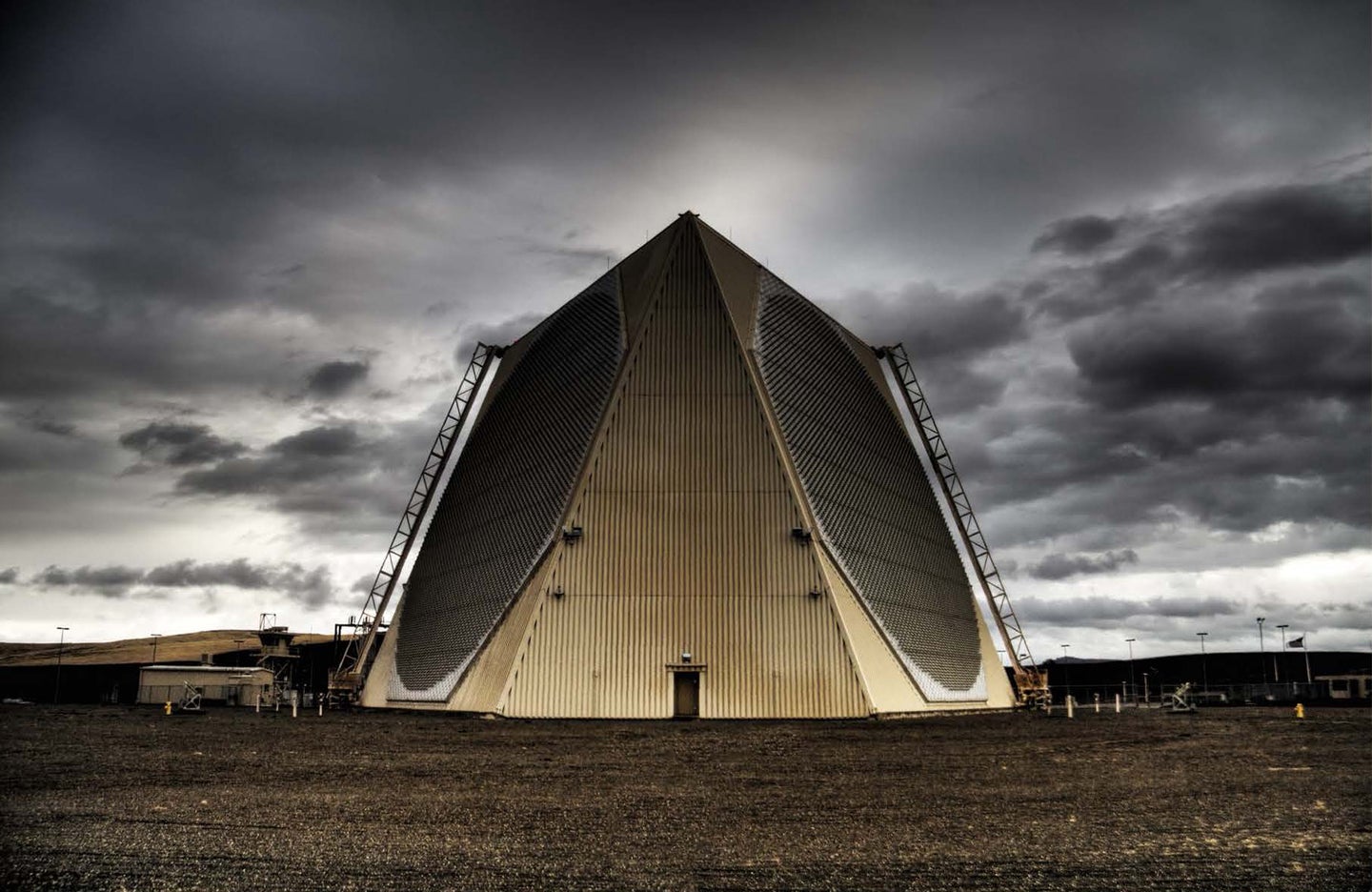
On July 14, the Center for Strategic and International Studies in Washington, DC held a one-day conference premised on a specific threat: What if, in the future, war comes to the United States via cruise missile? Pointing to new developments in cruise missile technology, and the limitations of existing early warning systems that are focused on the high arcing trajectories of ballistic missiles, the CSIS conference and accompanying report suggests that to defend the continental United States from such a threat, the military should adapt and deploy the kind of cruise missile defenses presently used as regional weapons.
Unlike ballistic missiles, which arc up into space before traveling back down towards earth, cruise missiles fly close to the ground, making it hard for radar on the ground that’s pointed up at space to see them.
The perceived threat from new cruise missiles is driven by tech developments occurring across the globe, as new materials, better aerodynamics, and sophisticated sensors and guidance systems make possible the fielding of weapons, like hypersonic missiles , that had mostly been just theoretical decades ago.
For the United States, the development of long-range bombers in the 1940s, followed by the development of intercontinental ballistic missiles, shattered the notion that the enormous distances of the Atlantic and Pacific oceans were enough to protect the continental US from direct attack. (During World War II, US territories in the Pacific came under direct attack, but the only long-range assault on the 48 states came in the form of incendiary-carrying balloons launched by Japan into the jet stream and carried over to the US.)
With atomic and then thermonuclear payloads, bombers and long-range missiles threatened devastation on an unprecedented scale, and the United States built an elaborate system of early warning sensors focused on detecting early signs of launch, and expanded its first-in-the-world nuclear arsenal to deter attack. North American Aerospace Defense Command (NORAD) is run by both Canada and the United States, and maintains a series of radars and other sensors designed to detect early attacks across the Arctic or elsewhere. (Every December, NORAD highlights its existence by tracking Santa Claus, turning a system designed to detect oblivion into a kid-friendly Christmas tradition .)
At the conference held by CSIS, the threat from cruise missiles was discussed as a way that other countries could attack the United States that is hard to detect by employing existing, ICBM-focused measures. It is also considered hard to deter through threat of nuclear retaliation, operating on the assumption that if a cruise missile with a conventional warhead destroyed a building or killed people in the United States, the President would not immediately respond with a nuclear strike.
“You know, our adversaries are building diverse, expansive ranges of modern offensive missile systems, and we see them – we see them in the news every day,” Stan Stafira, Chief Architect of the Pentagon’s Missile Defense Agency, told the panel. “They’re capable of maneuvering in the midcourse and the terminal phases of their flight, like maneuvering reentry vehicles, multiple independent reentry vehicles, hypersonic glide vehicles, and cruise missiles.”
Part of the broader appeal of hypersonic weapons to nations like Russia, China, and the United States is that the speed and trajectories of the missiles make them harder to detect than ICBMs. The ballistic arc of ICBMs means the launch is visible to radar while it is still ascending, once it clears the horizon line. Meanwhile, both hypersonic glide vehicles and hypersonic cruise missiles, which travel at Mach 5 or above, are designed to fly below that radar horizon, with the cruise missile keeping a close trajectory to earth and the glide vehicle flying in the high atmosphere.
“I want to state that we absolutely believe that nuclear deterrence is the foundation of homeland defense,” said Lieutenant General AC Roper, deputy commander of Northern Command, the part of the US military responsible for North America. “However, we also must have credible deterrence options below the nuclear thresholds, options which allow for a balanced approach of deterrence by denial and deterrence by punishment or cost imposition.”
Deterrence, at its most straightforward, is a strategy of making a big threat on a condition: One country publicly declares it will launch nukes at another if it launches nukes at it, with the intended effect that neither country launches nukes. But because the payload of a cruise missile—it could be nuclear or conventional, unlike ICBMs, which are always nuclear—is unlikely to be known until impact, generals like Roper would prefer to have a range of weapons with which to respond.
Missile defense is one of those options, and the US already employs a few forms. Part of any missile defense system is the sensors, like specially focused radar, that can detect incoming attacks, and then track those weapons as they travel. These radars then send that tracking information to interceptors, which are missiles launched to fly and destroy the incoming attacking missile. Shooting missiles at other missiles is a hard problem because an incoming threat arrives at great speed, and because the cost calculus can favor an attacker. Interceptors, like shorter-ranged Patriot missiles or longer-ranged ballistic interceptors , are often more expensive than the missiles they are intercepting. And unlike interceptors, which have to hit precisely to work, missiles launched in attack can deploy decoys or countermeasures to redirect interceptors away, or can instead be fired in a greater volume, overwhelming interceptors through sheer numerical advantage.
“The resulting 20-year cost to provide even a light defense of a vast area ranged from $77 billion to $466 billion,” reads the CSIS report , citing an analysis from the Congressional Budget Office studying a range of cruise missile defense options. “The considerable cost variation is due to alternative combinations of sensors and interceptors and varying desired warning times of 5 or 15 minutes.”

Kelsey D. Atherton is a military technology journalist who has contributed to Popular Science since 2013. He covers uncrewed robotics and other drones, communications systems, the nuclear enterprise, and the technologies that go into planning, waging, and mitigating war.
Like science, tech, and DIY projects?
Sign up to receive Popular Science's emails and get the highlights.
- Afghanistan
- North Korea
- South Korea
- Special Forces
- Weapons & Tech

Pakistan Navy launches first Hangor-class submarine in China.

The second Chinese overseas base is “fully operational.”

China’s new H-20 stealth bomber is of little concern to the…

India transfers ‘ship killer’ missiles to the Philippines

Ukraine cannot defeat Russia alone on the battlefield

The US is developing an unmanned submarine that resembles a stingray

The US National Guard owes more than 13,000 people pensions

Russia displays Abrams tanks and $4 million mine-clearing vehicles in Moscow.

Top 5 Weapons of India’s Elite Para Special Forces

Top 7 Israeli Special Forces Units

Delta Force vs SEAL Team Six: Comparison of the Two Elite…

Inside the United States Army Special Operations Command and Its Special…

United States Special Forces: A Guide to US Navy Special Operations…

MS Agamemnon: The Royal Navy’s New Submarine

The USAF E-3 Sentry Military Aircraft Radar in Detail

Carrier Based Aircraft: Which Countries Operate Them?

Derya ZY9: The Turkish Close Combat Solution

The Rockwell B-1 Lancer: A Key US Air Force Bomber

5 Notable Boeing Military Aircraft: From Air Force One to Maritime…

Top 10 Chinese Weapons Used by Guinean Military

8 Major Close-in weapon system (CIWS) in the World

Top 8 Fighter Jets in the World

4 Most Anticipated Weapons of China in 2024

Tejas Mk 1A vs. JF-17 – A Brief Comparison

German Leopard 2 vs. Russian T-90 Tank – The Ultimate Tank…

F-35 vs. F-22: Comparison of Lockheed Martin fighters

A Comparison of Top Naval Aviation Forces: China vs USA vs…

Comparing Battleships, Cruisers, Destroyers, and Frigates: What Are the Differences?
Tomahawk vs. kalibr: which cruise missile is more powerful.

Tomahawk Vs. Kalibr
Since the 1990s, the United States has relied on Tomahawk cruise missiles launched from their warships and submarines . The missile, with a flight capability of 550 miles per hour, has been involved in wars in the Middle East, North Africa, the former Yugoslavia, and Afghanistan.
The USS Merrill (DD-976) , an American destroyer ship, launched the first cruise missile in March 1980. in June of the same year, the UGM 109, the underwater version of the Tomahawk system, ran an Armament test.
The development of the military project lasted for two more years until 1983, when the missile system passed into service. The tomahawk cruise missiles were first used in Iraq in 1991 and symbolized the American idea of non-contact warfare.
When the U.S. first tried out the tomahawk missiles during the Operation Desert Storm , the Western media strongly praised its combat results.
However, in 1992 the New York Times And The Washington Post published an official report on the U.S. Department of Defense which described the lessons learned by the U.S. military during
the Gulf War and showed the real state of events, including the true capabilities of the Tomahawk. Tomahawks can strike targets at distances over a thousand miles away, making them very popular. However, now the Tomahawk has a strong competitor from Russia, The Kalibr.
The capacity to strike distant strategic targets deep within the land is seen as a crucial and differentiated capability for naval power.
It was assumed that only the United States and the United Kingdom possessed such technology before 2015 when the Tomahawk cruise missile was developed. But now, it’s not just the U.S. and U.K. that can engage targets with cruise missiles at extreme ranges.
Russian military forces first used the Kalibr missile system in Syria. The missiles were launched from warships and submarines at stationary targets .on October 7, 2015, the Russian Gepard-class frigates Dagestan and the three small bouillon class Corvettes sailing in the Caspian Sea fired 26 missiles at 11 Isis Targets in three Syrian governance, Araka, Idlib, and Aleppo.
The target distance was over 1500 kilometers; the targets included weapon factories, command centers, ammunition warehouses, weapons storage fuel Depots, and terrorist training camps. On November 20, 2015, the Caspian Fleet warships launched another 18-Kalibr cruise missiles at seven terrorist Targets in the same region.
The Kalibr missile system has been tested in real combat conditions; it is too early to estimate the cost of one missile and one launch, but the new Russian cruise missile has shown strong potential.

Missiles are currently deployed on Russian Navy kilo class submarines and more modern types, including the Akula Lada and Yasin classes.
They are also used on frigates and corvettes , although larger ships have not yet had them installed. Destroyers can carry many more missiles than Russian frigates, such as the Gephardt class, which only has eight Kalibr missiles.
There are a dozen or more Kalibr missile versions, each with its own unique launch platform, range, Target profile, and speed, and each carrying either a 990-pound Warhead or a nuclear payload.
The 3m14t and 3m14k land attack variants lack the Terminal approach Boost to Mach 3. Inertia-guided missiles have a range of 1000–1500 kilometers and use INS GPS and digital scene matching area correlation Dsmac to compare onboard camera images with recorded ones.
The Russian Navy will upgrade three M14 Kalibr cruise missiles to the Kalibr M version, which has a maximum shooting range of around 4,500 kilometers.
Now let’s see the Tomahawk missile.
The United States Navy and Royal Navy rely heavily on the Tomahawk, a long-range, all-weather, subsonic cruise missile. Tomahawk cruise missiles may use their inertial navigation systems to get where they need to go. GPS allows for pinpoint hits, travels at low altitudes, and can be reprogrammed mid-flight to alter its target direction.
When a cruise missile deviates from its intended course, this device compares the ground below it to the maps kept on board. Target in Flight delay, loiter option, and battle damage assessment over a two-way data link allow for the storage of up to 15 alternate pre-programmed targets prior to flight or acceptance of a new target.
Once a Tomahawk reaches its target, it can send back reconnaissance photos through Satcom to headquarters, where it will wait for further instructions.
Digital scene mapping from DSMAC allows it to wait around until the target is safe to engage. Tomahawk can be instructed to locate and track a single Target within a certain area by uploading a photo of that Target.

Block 5 upgrades to Tomahawk include:
- A redesigned Seeker can target surface targets over a thousand miles away with more penetrating force.
- Less susceptibility to jamming of its Seeker.
- Improved communication and navigation to strike the Target even if GPS is down.
The question is, which cruise missile is more powerful, Tomahawk or Kalibr?
The Kalibr Suite was made to be better than the U.S.’s many but old Tomahawk cruise missiles. Whereas the original Kalibr 3m14 and the tomahawks Block 4 of Revision were about the same in terms of performance, with a slight edge in favor of Kalibr.
Kalibr M drastically outranges its U.S. counterpart at 4500 against 1700 kilometers. The 3m14t and its relatives have a substantial advantage over the American-made Tomahawk since they may be fired from a greater variety of smaller ships.
Yet, the fact that it is being designed to be fired from stationary ground installations may lack the existing Tomahawk’s sophisticated loitering and interactive data link capabilities; however, this may make it easier and cheaper to mass produce.
In addition to Parts commonality with family variants.where Tomahawk likely outclasses Kalibr’s ECM capability. While Tomahawk’s four-block Revision included electronic countermeasures, the kalibr family is especially vulnerable when it comes to being jammed. Still, Tomahawk has strengthened its defenses with the addition of Block 5 to its modification process.
As far as network capabilities go, it outstrips even the most advanced cruise missiles in use. Given our current level of expertise, it would be futile to compare the two missiles based on their Kalibr alone. The Tomahawk has been used successfully in a battle for 30 years. Alternatively, the Kalibr didn’t appear until 2012.
Tomahawks are known for their pinpoint accuracy thanks to constant upgrades and improvements, but Russia doesn’t disclose the precision or reliability of its atomic missiles. In any case, the addition of large-Kalibr cruise missiles to the Russian Navy’s arsenal has increased its strategic potential.
RELATED ARTICLES MORE FROM AUTHOR

6 interesting facts about the flagship of the Russian Navy, Admiral Kuznetsov

How Important is the Nuclear Submarine?
Worth reading, 6 interesting facts about the flagship of the russian navy, admiral....

How the CIA Supported Ukraine During the Conflict

Israel’s F-35I Adir : The Best version of the stealth fighter...

What Defines Fifth Generation Fighters?

What other aircraft fly with US President’s Air Force One?

Can any aircraft beat the F-22 Raptor?

How many aircraft carriers will China build?

The Reasons Behind Iran’s Attack on Israel

How the Israeli Air Force could bring Iran to its knees

Who are the leading suppliers to the Israeli army?

Israel-Iran tensions expose America’s difficult position in the Middle East.
- February 2024
- January 2024
- December 2023
- Terms & Conditions
- Privacy Policy
POPULAR CATEGORIES
- Weapons & Tech 559
- Worth Reading 243
Copyright©Militaryview.com 2023

Russian S-500 Prometheus : Is it a Formidable Challenger to F-22...

Homebase >
Publications >
The Differences Between Unmanned Aircraft, Drones, Cruise Missiles and Hypersonic Vehicles
By lieutenant colonel, by lt col, andreas, schmidt.
Joint Air Power Competence Centre
Andre
haider.
- Additional Authors
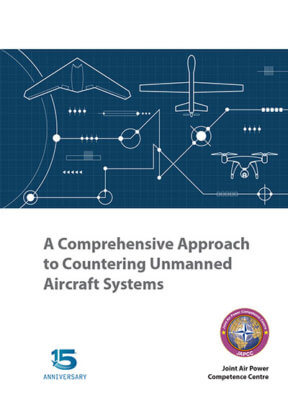
Introduction
To define the impact of unmanned aerial systems on current and future NATO operations, it is very important to identify which kind or category of threats are included and which are not. This section will try to clarify this definition and will show that a clear classification is sometimes not easy to achieve.
A threat is typically defined as the combination of malevolent intent and the ability to put it into action. Further subcategories of this overarching term exist, such as ‘air threat’ to better describe the operational environment and to categorize or delineate measures, like ‘air defence’ to counter the respective threat. The set of all capabilities that qualify as air threats is so diverse and complex that no singular system can be used to execute air defence. Additionally, the question of what constitutes an air threat is not an easy one. Is an air threat any capability that uses the air as its main or final domain for effect delivery? If that were the case, a projectile from a rifle would be an air threat, which is not the case. However, the defence against larger projectiles like artillery shells or mortar rounds, which are a typical ground threat, finally became part of air defence considerations after Counter-Rocket-Artillery-Mortar (C-RAM) systems had been developed and fielded.
Defining Unmanned Aircraft
Since this document is about the threat of Unmanned Aircraft Systems (UAS), the term Unmanned Aircraft (UA) needs to be looked at. Currently, NATO defines UA as an aircraft that does not carry a human operator and which is operated remotely using various levels of automated functions. 1 UA can be expendable or recoverable and may carry lethal or non-lethal payloads. Of note, cruise missiles are categorically excluded from this NATO definition. As this definition is very broad, the term aircraft needs to be described for a better understanding. The ICAO (International Civil Aviation Organization) defines an aircraft as any machine that can derive support in the atmosphere from the reactions of the air other than the reactions of the air against the earth’s surface. 2
By this portrayal alone, all projectiles that only have initial propulsion and then just follow a ballistic trajectory (e.g. bullets, artillery shells, regular bombs or ballistic missiles) can be excluded from the aircraft category. For the purpose of this paper, also ordnance which uses aerodynamic lift or other interactions with the atmosphere just to extend the ballistic flight path will be excluded from the UA category as well. This removes threats like gliding bombs or hypersonic glide vehicles from the UA set, although they could be remotely operated and definitely possess automated functions. Emerging technologies (e.g. new propulsions, swarming or Artificial Intelligence) might create fringe threat sets, which generally show UA properties, but are currently not considered as such.
An extended definition proposal of Unmanned Aircraft (UA)
Vehicles that use aerostatic or aerodynamic lift, and overall don’t generally fly on a ballistic trajectory can be categorized as an aircraft. These vehicles can be propelled by a motor (e.g. rotary or jet) to create lift and sustain flight. If these aircraft do not house a pilot within the airframe and are operated remotely using various levels of automated functions, they are considered an UA, excluding cruise missiles.
Cruise Missiles versus Unmanned Aircraft
In general, making the distinction between ordnance and UA is not useful, due to tremendous technical progress. These two categories are not exclusive anymore, while not every ordnance is a UA, a UA can be used as ordnance. In times of mass production, innovative propulsion systems and reliable effect delivery without a pilot on board, the idea of using the vehicle as ordnance itself became more prevalent. While the V1 in WWII initially had a CEP (Circular Error Probable) of more than 10 km and most use cases were aimed at producing terror, today´s cruise missiles have a CEP of 10 meters or less. The cost/benefit ratio between losing the UA while creating a certain effect or enabling it to deliver the same effect while remaining retrievable has shifted significantly in times of precise technological options and relatively cheap production cost, especially for small UA.
Drone versus Unmanned Aircraft
The terms ‘Unmanned Aircraft’ and ‘Drone’, as well as variations such as ‘Unmanned Aerial Vehicle (UAV)’ 3 or ‘Remotely Piloted Aircraft (RPA)’ 4 are often used interchangeably but are actually deliberately defined to reflect certain classes, attributions or certifications of the unmanned systems.
When having to counter these systems, the most relevant factors are overall system complexity and aircraft size. Therefore, this book summarizes the different categories and classes of unmanned systems under the following two terms:
Unmanned Aircraft
The term ‘Unmanned Aircraft’ describes the overall set of vehicles, as described above. However, this book uses the term ‘UA’ to address military systems falling into the NATO Class II and III categories. UA are typically part of a complex system that can include dedicated Ground Control Stations, Mission Control Elements, multiple aircrews, military-grade communication systems, as well as dedicated infrastructure for logistics and maintenance. UA are usually operated by well-trained personnel, often qualified pilots, to safely operate alongside other airspace users. When addressing not only the aircraft but also other system components or the system as a whole, this book uses the term ‘Unmanned Aircraft System’ or ‘UAS’.
The term ‘drone’ is commonly used and widely accepted in the civil domain for all kinds of unmanned systems. Hence, this book uses the term ‘drone’ to address all types of consumer and commercial systems, which are generally smaller and less complex than their military counterparts. ‘Drone’ implies that the system is typically operated by a single, not necessarily qualified individual, from a handheld remote control, in relatively close proximity to the aircraft, and under Line-of-Sight (LOS) conditions. Therefore, this book also uses ‘drone’ for most military systems falling into the NATO Class I category, as their size and complexity is quite comparable to commercially available consumer models and therefore require a similar approach when having to counter them.

‘Unmanned Aircraft’, Record #7915, NATO Terminology Database, [Online]. Available: https://nso.nato.int/natoterm/Web.mvc. [Accessed 15 Jul. 2019].
International civil aviation organization (icao), ‘international standards and recommended practices, annex 6, operation of aircraft, part i’, 25 feb. 2013. [online]. available: https://www.icao.int/safety/fatiguemanagement/frms%20tools/amend- ment%2037%20for%20frms%20sarps%20%28en%29.pdf. [accessed 15 jul. 2019]., the term unmanned aerial vehicle (uav) is no longer in use by nato but is often still used in the civil and public domain., the term remotely piloted aircraft (rpa) is used to indicate that the ua is required to be controlled by a pilot who has been trained and certified to the same standards as a pilot of a manned aircraft..
- About the authors
- Other chapters in this book
Related Publications
joined the German Air Force in 1993. After attending Officers School, he studied Computer Science at the German Armed Forces University in Munich. Since 1998 he built up an extensive background in Ground Based Air Defence, particularly the PATRIOT weapon system. He started as a Tactical Control Officer and subsequently held positions as Reconnaissance Officer, Battery Executive Officer and Battery Commander in various PATRIOT units. Furthermore, he had two non-consecutive assignments in Fort Bliss, Texas. The main task of his first assignment was to conduct bilateral US-GE studies of weapon system behaviour on a tactical level for the German PATRIOT Office.
During his second assignment, he was the Subject Matter Expert (SME) on Integrated Air and Missile Defence at the German Luftwaffe Air Defence Centre. In between, he had an assignment as the A3C in the former Air Force Division. Currently, he is the Integrated Air and Missile Defence / Ballistic Missile Defence SME in the JAPCC.

Lieutenant Colonel Haider began his military career with the German Armed Forces in April 1992. He initially served as a Personnel NCO in the 150th Rocket Artillery Battalion HQ. Following his promotion to Lieutenant in 1998, he took on the role of an MLRS platoon leader within the same battalion. After three years, he transitioned to the position of CIS Branch Head at the 150th Rocket Artillery Battalion HQ. Subsequently, Lieutenant Colonel Haider was assigned to the 325th Tank Artillery Battalion, where he served as a battery commander before assuming command of the maintenance and supply battery. In 2008, he was appointed as the commander of the maintenance and supply company within the 284th Signal Battalion. His responsibilities expanded in 2010 when he became the Deputy Commander of the German support staff for the 1st NATO Signal Battalion. As a follow-on assignment, he served as the Deputy Battalion Commander of the 132nd Rocket Artillery Battalion.
Since 2012, Lieutenant Colonel Haider has been a Subject Matter Expert for Unmanned Aircraft Systems and Countering Unmanned Aircraft Systems within the JAPCC Combat Air Branch. Lieutenant Colonel Haider represents the JAPCC in and contributes to several key NATO groups, including the NATO Joint Capability Group Unmanned Aircraft Systems, the NATO Counter-UAS Working Group, and the NATO Joint Capability Group Maritime Unmanned Systems.

Other Chapters in this Book
Part i - overview, unmanned aircraft system threat vectors, the vulnerabilities of unmanned aircraft system components, a methodology for countering unmanned aircraft systems, part ii - military perspectives, space operations, joint intelligence, surveillance, and reconnaissance, defensive counter-air operations, offensive counter-air operations, electromagnetic operations, cyberspace operations, strategic communications, force protection considerations, command and control, education and training, part iii - civil perspectives, protection of critical infrastructure, cloud-based command and control for security and drone defence applications, drone forensics, law enforcement, part iv - legal perspectives, arms control of unmanned weapons systems, regulatory frameworks in support of counter-uas, the juridical landscape of countering unmanned aircraft systems, part v - future perspectives, future threats: military uas, terrorist drones, and the dangers of the second drone age, research, development, and acquisition of counter-uas technologies, employing friendly uas for counter-uas operations.

Drone Drills

Electronic Warfare in Ukraine

The Heart of Decision Superiority

It’s a Question of Gender!

Defining the Swarm

Human-Machine Interface: An Evolutionary Necessity

High-Altitude Platform Systems

Potential Game Changer for Close Air Support

Contact Information
Joint Air Power Competence Centre Römerstrasse 140 47546 Kalkar Germany
- +49 (0) 2824 90 2201
- North Atlantic Treaty Organization (NATO)
- Allied Command Operations (ACO)
- Allied Command Transformation (ACT)
- NATO Centres of Excellence
Collaboration
- SharePoint Environment
- JAPCC Webmail
- NATO Air & Space Power Community
- Request for Support
- 2005-2024 Joint Air Power Competence Centre
Quick Search
More results...

Please leave us a message
- Competencies
- Publications
- Legal Notice & Disclaimer
- Privacy Policy
- Work & Careers
- Life & Arts
Become an FT subscriber
Try unlimited access Only $1 for 4 weeks
Then $75 per month. Complete digital access to quality FT journalism on any device. Cancel anytime during your trial.
- Global news & analysis
- Expert opinion
- Special features
- FirstFT newsletter
- Videos & Podcasts
- Android & iOS app
- FT Edit app
- 10 gift articles per month
Explore more offers.
Standard digital.
- FT Digital Edition
Premium Digital
Print + premium digital, weekend print + standard digital, weekend print + premium digital.
Today's FT newspaper for easy reading on any device. This does not include ft.com or FT App access.
- Global news & analysis
- Exclusive FT analysis
- FT App on Android & iOS
- FirstFT: the day's biggest stories
- 20+ curated newsletters
- Follow topics & set alerts with myFT
- FT Videos & Podcasts
- 20 monthly gift articles to share
- Lex: FT's flagship investment column
- 15+ Premium newsletters by leading experts
- FT Digital Edition: our digitised print edition
- Weekday Print Edition
- Videos & Podcasts
- Premium newsletters
- 10 additional gift articles per month
- FT Weekend Print delivery
- Everything in Standard Digital
- Everything in Premium Digital
Essential digital access to quality FT journalism on any device. Pay a year upfront and save 20%.
- 10 monthly gift articles to share
- Everything in Print
Complete digital access to quality FT journalism with expert analysis from industry leaders. Pay a year upfront and save 20%.
Terms & Conditions apply
Explore our full range of subscriptions.
Why the ft.
See why over a million readers pay to read the Financial Times.
International Edition

The most comprehensive and authoritative history site on the Internet.
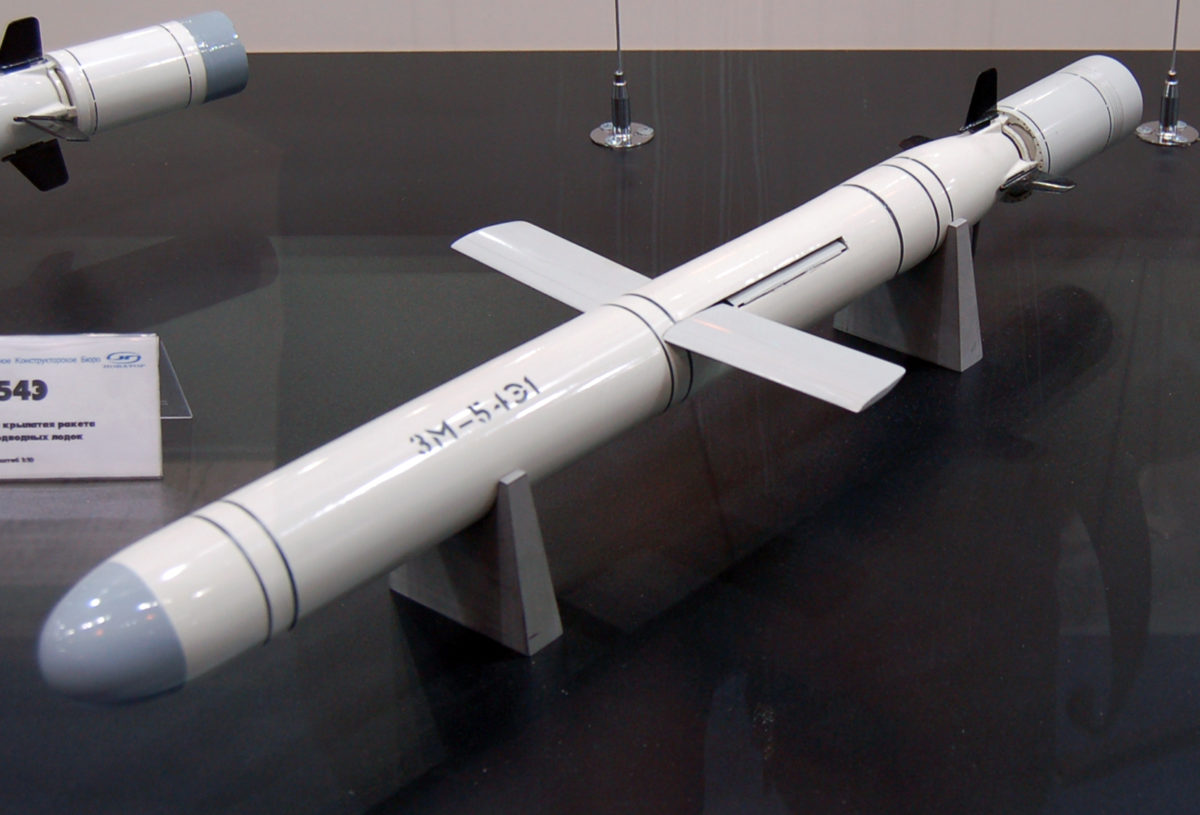
3M-54 Kalibr: Is Russia’s Most Advanced Cruise Missile Being Wasted in Ukraine?
The current war between Russia and Ukraine has seen a wide variety of sophistication in the weaponry on both sides. Although the Russians seem to have enjoyed the most success where they concentrate great numbers of such relatively simple but deadly weapons as tanks and artillery, they have also made considerable use of the most technologically advanced items in their arsenal.
These are the 3M-54 Kalibr cruise missile and its various derivatives.
GET HISTORY’S GREATEST TALES—RIGHT IN YOUR INBOX
Subscribe to our HistoryNet Now! newsletter for the best of the past, delivered every Monday and Thursday.
History of the Kalibr
The 3M-54 Kalibr was developed by the Novator Design Bureau in 1994 as a counter to the American Tomahawk cruise missile and has been under production in various forms ever since. The North Atlantic Treaty Organization codenames it the SS-N-27 Sizzler.
Kalibrs launched from warships in the Mediterranean Sea were extensively used during the Russian involvement in the Syrian Civil War between October 2015 and December 2018.
Recommended for you
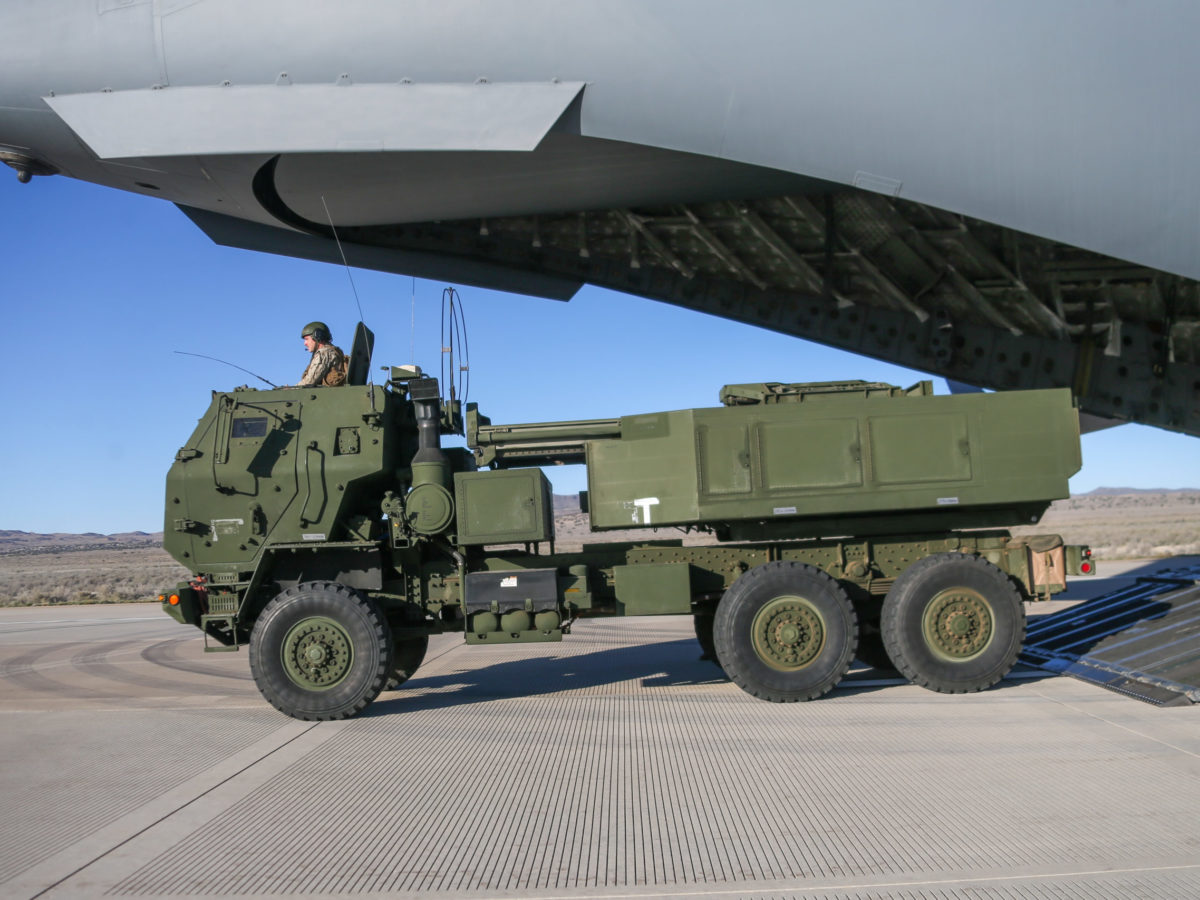
M142 HIMARS: The US Artillery Tearing Into Russia in Ukraine
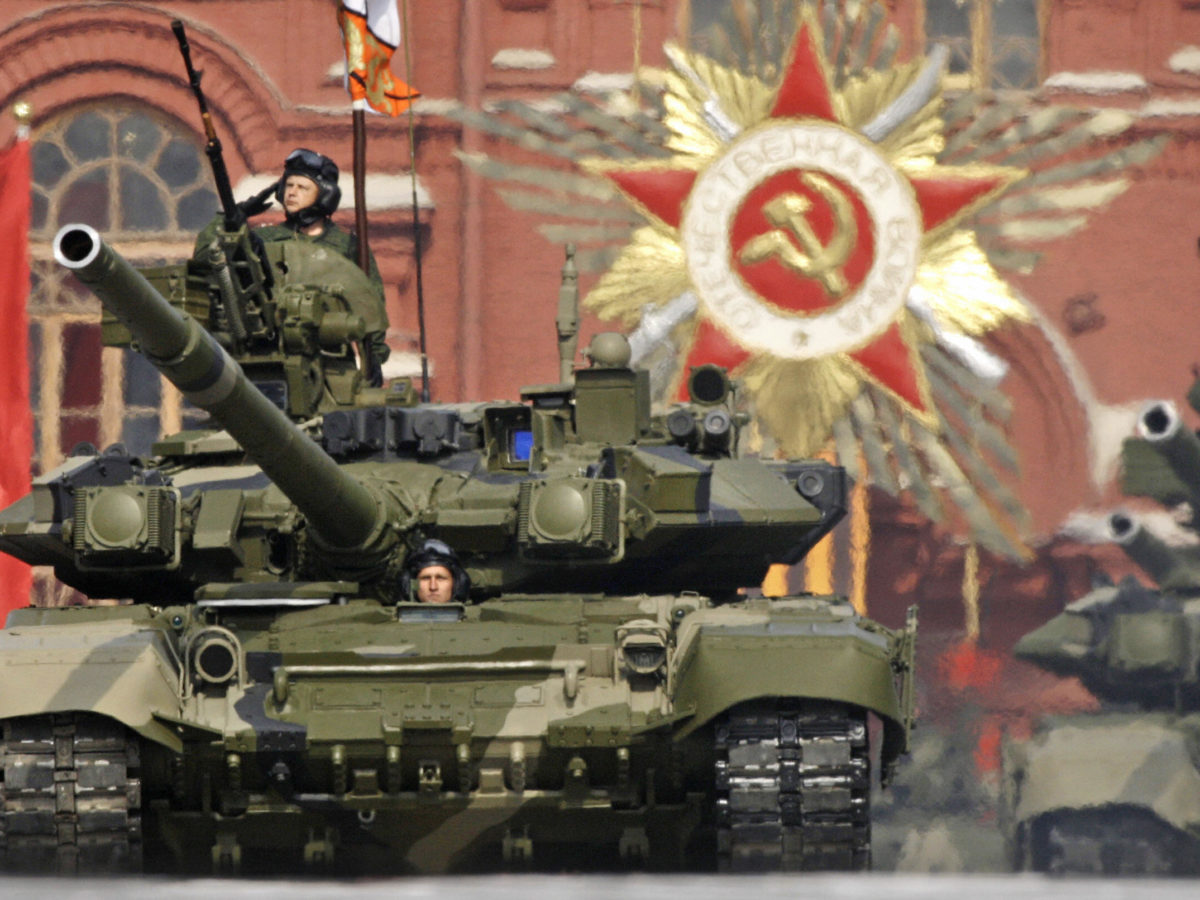
The T-90 Tank: Russia’s First Main Battle Tank
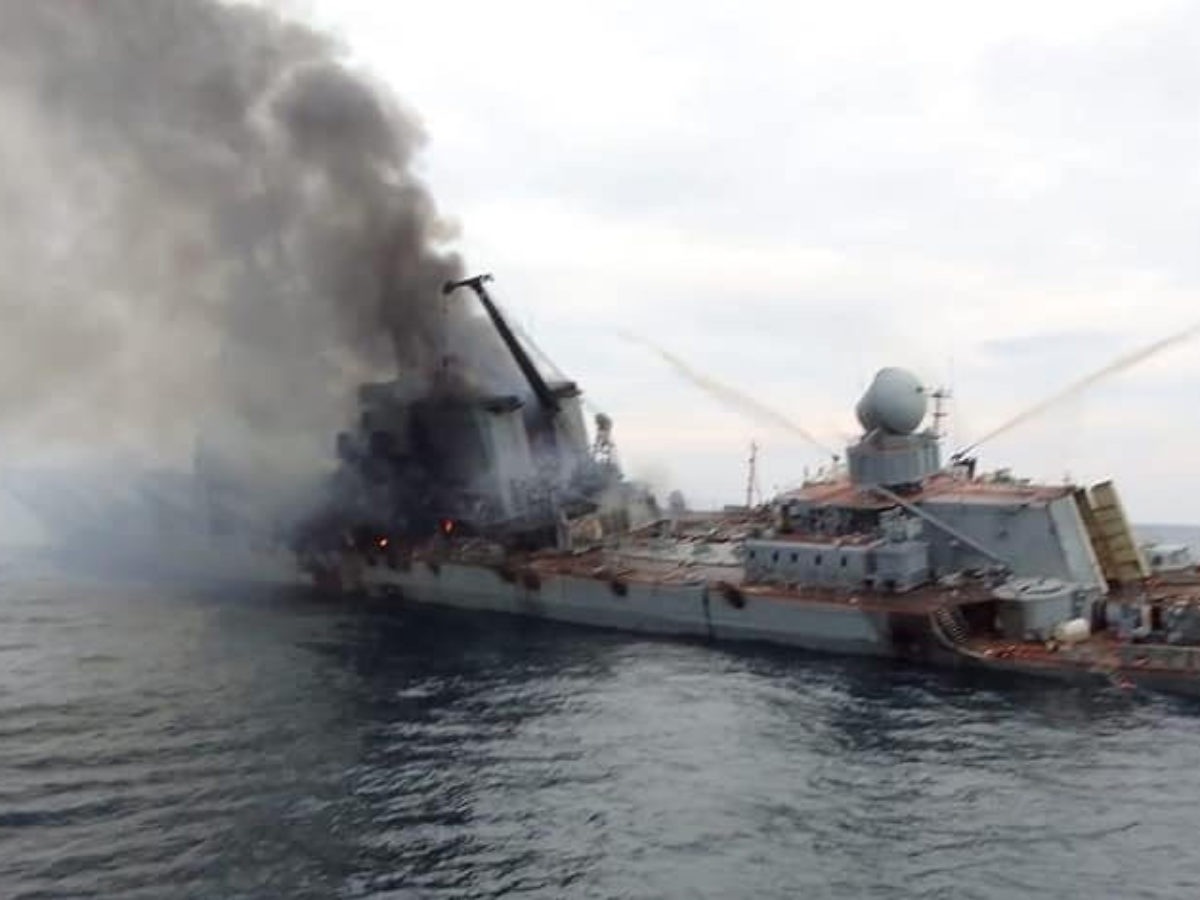
The Neptune Anti-Ship Missile: The Weapon That May Have Sunk the Russian Flagship Moskva
The kalibr’s stats.
With a length of 8.9 meters (29 feet) and a diameter of 5.33 meters (17.5 feet), the basic Kalibr is a multistage, solid-fuel turbojet with a modular propulsion system to accommodate five versions: two anti-ship, two anti-submarine and one for land targets. Depending on size, performance and launching platform, the other variants go under such designations as 3M14 Biryuza (“turquoise”), 3M-14T Kalibr-NK and 3M-14K Kalibr-PL. More advanced versions are still under development, to improve “combat efficiency.”
Existing variants are capable of being fired from warships as small as a corvette, from submarines and from land vehicles. All use vertical launch systems. They reach their targets through a combination of inertial guidance plus terminal active radar homing, although more current variants have been modified to use satellite signals using a DSMAC (digital scene matching area correlator).
Range varies from 220 to 2,500 kilometers (140 to 1,550 miles), depending on whether the second propulsion stage is driving the warhead at a supersonic sprint or cruising along at subsonic speed for greater range.
The missile can carry from 400 to 500 kilograms (880 to 1,100 pounds) of high explosive or a nuclear warhead at Mach 0.8, 2.5 or 3.
The Kalibr in UKraine
After Syria, the next major usage of the Kalibr came on Feb. 24, 2022, when some 30 missiles helped herald the “special operation” in Ukraine. Above the cacophony of guns, the cruise missiles turn up from time to time in incidents that make the international news.
Between June 25 and 26, 60 to 80 missiles were launched, of which 30 were aimed at Zhytomir, 10 of which were shot down short of their targets by Ukrainian defenses. On July 14, three Kalibrs hit the city center of Vinnytsia, killing about 20 people — three of them children. Ukraine reported that its defenses shot down two more of the missiles. On July 23, Maria Zakharova of the Russian Telegram reported that “Kalibr missiles destroyed military infrastructure in the port of Odesa, with a high-precision strike.” Ukrainian President Volodymyr Zelenskyy quickly denied that the Russian strikes had involved any tactical precision.
The Russian military pays a price for the Kalibr’s capabilities, since each missile costs an average of $6.5 million each. Up for debate amid a war that has entered its sixth month is whether Russia’s most advanced missile is indeed being guided to vital military targets or simply joining the general barrage of roughly aimed ordnance, wasting its primary asset. Each side has its own appraisal, but the truth will ultimately be revealed over the battlefield.
historynet magazines
Our 9 best-selling history titles feature in-depth storytelling and iconic imagery to engage and inform on the people, the wars, and the events that shaped America and the world.
Related stories

Portfolio: Images of War as Landscape
Whether they produced battlefield images of the dead or daguerreotype portraits of common soldiers, […]

Jerrie Mock: Record-Breaking American Female Pilot
In 1964 an Ohio woman took up the challenge that had led to Amelia Earhart’s disappearance.

Buffalo Bill’s Tours of Italy and the ‘Spaghetti Western’ Inspired Replica Old West Firearms
Rifles and revolvers made by Uberti, Pietta, Pedersoli and other Italian firms remain popular.

Even in the Headline-Grabbing World of Drones, the Predator Stands Out
The MQ-1 accumulated more than 1 million flight hours in reconnaissance and combat missions.
- Election 2024
- Entertainment
- Newsletters
- Photography
- Personal Finance
- AP Investigations
- AP Buyline Personal Finance
- AP Buyline Shopping
- Press Releases
- Israel-Hamas War
- Russia-Ukraine War
- Global elections
- Asia Pacific
- Latin America
- Middle East
- Election Results
- Delegate Tracker
- AP & Elections
- Auto Racing
- 2024 Paris Olympic Games
- Movie reviews
- Book reviews
- Personal finance
- Financial Markets
- Business Highlights
- Financial wellness
- Artificial Intelligence
- Social Media
North Korea says it tested ‘super-large’ cruise missile warhead and new anti-aircraft missile
Korean Central News Agency released photos showing at least two missiles being fired off launcher trucks on a runway. The missiles in the image were not identified. State media said North Korea’s missile administration on Friday conducted a ‘power test’ for the warhead designed for the Hwasal-1 Ra-3 strategic cruise missile and a test-launch of the Pyoljji-1-2 anti-aircraft missile.

The South Korean and U.S. air forces held joint air drills in Gunsan, South Korea on Friday, where they practiced ways to detect and counter enemy threats.
A TV screen shows an image of North Korea’s missile launch during a news program at the Seoul Railway Station in Seoul, South Korea, Saturday, April 20, 2024. North Korea said Saturday it tested a “super-large” cruise missile warhead and a new anti-aircraft missile in a western coastal area as it expands military capabilities in the face of deepening tensions with the United States and South Korea. (AP Photo/Ahn Young-joon)
- Copy Link copied
South Korean army soldiers pass by the barbed-wire fence in Paju, South Korea, near the border with North Korea, Friday, April 19, 2024. (AP Photo/Ahn Young-joon)
A U.S. Army soldier from the Eighth Army and South Korean army soldiers throw simulated grenades during the Expert Soldier, Infantry, and Medic Badge (E3B) competition at the Rodriguez Live Fire Complex in Pocheon, South Korea, Friday, April 19, 2024. (AP Photo/Ahn Young-joon)
U.S. Army soldiers from the Eighth Army compete during the Expert Soldier, Infantry, and Medic Badge (E3B) competition at the Rodriguez Live Fire Complex in Pocheon, South Korea, Friday, April 19, 2024. (AP Photo/Ahn Young-joon)
SEOUL, South Korea (AP) — North Korea said Saturday it tested a “super-large” cruise missile warhead and a new anti-aircraft missile in a western coastal area as it expands military capabilities in the face of deepening tensions with the United States and South Korea.
North Korean state media said the country’s missile administration on Friday conducted a “power test” for the warhead designed for the Hwasal-1 Ra-3 strategic cruise missile and a test-launch of the Pyoljji-1-2 anti-aircraft missile. It said the tests attained an unspecified “certain goal.”
Photos released by the North’s official Korean Central News Agency showed at least two missiles being fired off launcher trucks at a runway.
North Korea conducted a similar set of tests Feb. 2, but at the time did not specify the names of the cruise missile or the anti-aircraft missile, indicating it was possibly seeing technological progress after testing the same system over weeks.
KCNA insisted Friday’s tests were part of the North’s regular military development activities and had nothing to do with the “surrounding situation.”
Tensions on the Korean Peninsula are at their highest in years, with North Korean leader Kim Jong Un dialing up his weapons demonstrations, which have included more powerful missiles aimed at the U.S. mainland and U.S. targets in the Pacific. The United States, South Korea and Japan have responded by expanding their combined military training and sharpening their deterrence strategies built around strategic U.S. assets.
Cruise missiles are among a growing collection of North Korean weapons designed to overwhelm regional missile defenses. They supplement the North’s vast lineup of ballistic missiles, including intercontinental ballistic missiles aimed at the continental United States.
Analysts say anti-aircraft missile technology is an area where North Korea could benefit from its deepening military cooperation with Russia , as the two countries align in the face of their separate, intensifying confrontations with the U.S. The United States and South Korea have accused North Korea of providing artillery shells and other equipment to Russia to help extend its warfighting in Ukraine.

North Korea's Cruise Missile Tests Escalate Tensions Amidst Stalled Diplomacy
N orth Korea has once again ratcheted up tensions with the firing of several cruise missiles, according to South Korea’s military. The launches took place near Sinpo, a key military shipyard on the North’s east coast where missile-firing submarines are constructed. This latest demonstration of North Korea’s expanding arsenal raises concerns about regional security and the potential for escalated military confrontation.
The recent missile tests are part of a broader series of weapons demonstrations that include last week’s unveiling of a new cruise missile, Pulhwasal-3-31, and the test-firing of the country’s first solid-fuel intermediate-range ballistic missile on January 14. These activities underscore North Korean leader Kim Jong Un’s efforts to develop weaponry capable of evading missile defenses in South Korea and Japan, as well as targeting remote U.S. assets in the Pacific, such as Guam.
Pyongyang’s steady pace in cruise missile launches, at least ten rounds since 2021, demonstrates an aim to enhance its strike capabilities. The claimed range of these missiles, up to 2,000 kilometers, poses a stark threat to U.S. military bases in Japan. Although these cruise missile activities are not directly banned under United Nations sanctions, experts warn they pose a serious threat due to their ability to fly at low altitudes, making them harder to detect by radar.
Tensions on the Korean Peninsula have been on the upswing for months, with Kim Jong Un continuing to advance his weapons development and issuing threats of nuclear conflict against the U.S. and its Asian allies. In response, the U.S., South Korea, and Japan have been intensifying their military exercises and refining their deterrence strategies, involving nuclear-capable U.S. assets.
North Korea, meanwhile, has described its weapons tests as part of regular efforts to strengthen its military and indicated that some missiles have “strategic” purposes, suggesting they may be intended for nuclear armament.
The implications of these developments are far-reaching. On the one hand, they reflect North Korea’s determination to bolster its leverage in any potential future negotiations with the U.S. On the other hand, they complicate the already strained security situation in the region. North Korea’s actions have not only drawn sharp condemnation from South Korea and Japan but also from the U.S. These missile tests come at a time when diplomacy with the United States and South Korea remains stalled, with observers suggesting that Pyongyang believes an upgraded weapons arsenal could grant it greater concessions should talks resume.
Relevant articles:
– North Korea fires missile into ocean in its latest weapons launch, South Korea says , ABC News, 05/01/2024
– North Korea fires salvo of short-range ballistic missiles , Yahoo News UK, 04/29/2024
– North Korea fires ballistic missiles as Blinken visits Seoul , Yahoo News Canada, 04/29/2024

- Today's news
- Reviews and deals
- Climate change
- 2024 election
- Fall allergies
- Health news
- Mental health
- Sexual health
- Family health
- So mini ways
- Unapologetically
- Buying guides
Entertainment
- How to Watch
- My watchlist
- Stock market
- Biden economy
- Personal finance
- Stocks: most active
- Stocks: gainers
- Stocks: losers
- Trending tickers
- World indices
- US Treasury bonds
- Top mutual funds
- Highest open interest
- Highest implied volatility
- Currency converter
- Basic materials
- Communication services
- Consumer cyclical
- Consumer defensive
- Financial services
- Industrials
- Real estate
- Mutual funds
- Credit cards
- Balance transfer cards
- Cash back cards
- Rewards cards
- Travel cards
- Online checking
- High-yield savings
- Money market
- Home equity loan
- Personal loans
- Student loans
- Options pit
- Fantasy football
- Pro Pick 'Em
- College Pick 'Em
- Fantasy baseball
- Fantasy hockey
- Fantasy basketball
- Download the app
- Daily fantasy
- Scores and schedules
- GameChannel
- World Baseball Classic
- Premier League
- CONCACAF League
- Champions League
- Motorsports
- Horse racing
- Newsletters
New on Yahoo
- Privacy Dashboard
Russia produces several dozen cruise missiles per month — Defense Intelligence
Ukraine’s Defense Intelligence (HUR) provided an estimate of Russia’s stockpile and output of cruise missiles , including types such as Zircon, Oniks, Kalibr, and Kh-69. The figures were published by defense-focused media outlet ArmyInform on May 1.
According to Ukrainian intelligence, Russia retains approximately 40 Zircon hypersonic anti-ship cruise missiles, with production rates of up to 10 monthly.
Around 400 Oniks cruise missiles remain at Moscow’s disposal, with a similar output of up to 10 units per month.
The Russian Navy has approximately 270 Kalibr sea-launched cruise missiles, with a production rate of 30 to 40 units per month.
Only 45 Kh-69 air-launched missiles remain in stock, with only three being manufactured monthly.
Earlier, Ukrainian officials warned of potential Russian missile attacks on Ukraine during the Orthodox Easter festivities.
Read also: How do Russia's Kh-69 missiles measure up against the West's best?
We’re bringing the voice of Ukraine to the world. Support us with a one-time donation, or become a Patron !
Read the original article on The New Voice of Ukraine
Recommended
Breaking news, iran just pulled its own nuclear teeth.
- View Author Archive
- Get author RSS feed
Thanks for contacting us. We've received your submission.
Details of the recent limited Israeli retaliatory strike against Iranian anti-aircraft missile batteries at Isfahan are still sketchy. Nonetheless, we can draw some conclusions.
Israel’s small volley of missiles hit their intended targets, to the point of zeroing in on the very launchers designed to stop such incoming ordnance.
The target was near the Natanz enrichment facility. That proximity was by design: Israel showed Iran it could take out the very anti-missile battery designed to thwart an attack on its nearby nuclear facility.
The larger message sent to the world was that Israel could send a retaliatory barrage at Iranian nuclear sites with reasonable assurances that the incoming attacks could not be stopped.
By comparison, Iran’s earlier attack on Israel was much greater and more indiscriminate.
It was also a huge flop, with an estimated 99% of the more than 320 drones, cruise missiles and ballistic missiles failing to hit their planned targets .
Moreover, it was reported that more than 50% of Iran’s roughly 115 to 120 ballistic missiles failed at launch or malfunctioned in flight.
Collate these facts and it presents a disturbing corrective to Iran’s nonstop boasts of soon possessing a nuclear arsenal that will obliterate the Jewish state.
Consider further the following nightmarish scenarios: Were Iranian nuclear-tipped missiles ever launched at Israel, they could pass over, in addition to Syria and Iraq, either Saudi Arabia, Jordan, the West Bank, Gaza or all four.
In the cases of Jordan and Saudi Arabia, such trajectories would constitute an act of war, especially considering that some of Iran’s recent aerial barrages were intercepted and destroyed over Arab territory well before they reached Israel.
Iran’s strike prompted Arab nations, the US, the UK and France to work in concert to destroy almost all of Iran’s drones.
For Iran, that is a premonition of the sort of sophisticated aerial opposition it might face if it ever decided to stage a nuclear version.
Even if half of Iran’s ballistic missiles did launch successfully, only a handful apparently neared their intended targets — in sharp contrast to Israel’s successful attack on Iranian missile batteries.
Is it thus conceivable that any Iranian nuclear-tipped missile launched toward Israel might pose as great a threat to Iran itself or its neighbors as to Israel?
And even if such missiles made it into the air and even if they successfully traversed Arab airspace, there is still an overwhelming chance they would be neutralized before detonating above Israel.
Any such launch would warrant an immediate Israeli response. And the incoming bombs and missiles would likely have a 100% certainty of evading Iran’s countermeasures and hitting their targets.
Get opinions and commentary from our columnists
Subscribe to our daily Post Opinion newsletter!
Thanks for signing up!
Please provide a valid email address.
By clicking above you agree to the Terms of Use and Privacy Policy .
Never miss a story.
Now that the soil of both Iran and Israel is no longer sacred and immune from attack, the mystique of the Iranian nuclear threat has dissipated.
It should be harder for the theocracy to shake down Western governments for hostage bribes, sanctions relief and Iran-deal giveaways on the implied threat of Iran successfully nuking the Jewish state.
The new reality is that Iran has goaded an Israel that has numerous nuclear weapons and dozens of nuclear-tipped missiles in hardened silos and on submarines.
Tehran has zero ability to stop any of these missiles or sophisticated fifth-generation Israeli aircraft armed with nuclear bombs and missiles.
Iran must now fear that if it launched two or three nuclear missiles, there would be overwhelming odds that they would either fail at launch, go awry in the air, implode inside Iran, be taken down over Arab territory by Israel’s allies or be knocked down by the tripartite Israel anti-missile defense system.
Add it all up, and the Iranian attack on Israel seems a historic blunder.
It showed the world the impotence of an Iranian aerial assault at the very time it threatens to go nuclear.
It revealed that an incompetent Iran may be as much a threat to itself as to its enemies.
It opened up a new chapter in which its own soil, thanks to its attack on Israel, is no longer off limits to any Western power.
Its failure to stop a much smaller Israel response, coupled with the overwhelming success of Israel and its allies in stopping a much larger Iranian attack, reminds the Iranian autocracy that its shrill rhetoric is designed to mask its impotence and to hide its own vulnerabilities from its enemies.
And the long-suffering Iranian people?
The truth will come out that its own theocracy hit the Israeli homeland with negligible results and earned a successful, though merely demonstrative, Israeli response in return.
So Iranians will learn their homeland is now vulnerable and, for the future, no longer off limits.
And they will conclude that Israel has more effective allies than Iran and that their own ballistic missiles may be more suicidal than homicidal.
As a result, they may conclude that the real enemies of the Iranian nation are not the Jewish people of Israel after all, but their own unhinged Islamist theocrats.
Share this article:
- Today's news
- Reviews and deals
- Climate change
- 2024 election
- Fall allergies
- Health news
- Mental health
- Sexual health
- Family health
- So mini ways
- Unapologetically
- Buying guides
Entertainment
- How to Watch
- My watchlist
- Stock market
- Biden economy
- Personal finance
- Stocks: most active
- Stocks: gainers
- Stocks: losers
- Trending tickers
- World indices
- US Treasury bonds
- Top mutual funds
- Highest open interest
- Highest implied volatility
- Currency converter
- Basic materials
- Communication services
- Consumer cyclical
- Consumer defensive
- Financial services
- Industrials
- Real estate
- Mutual funds
- Credit cards
- Balance transfer cards
- Cash back cards
- Rewards cards
- Travel cards
- Online checking
- High-yield savings
- Money market
- Home equity loan
- Personal loans
- Student loans
- Options pit
- Fantasy football
- Pro Pick 'Em
- College Pick 'Em
- Fantasy baseball
- Fantasy hockey
- Fantasy basketball
- Download the app
- Daily fantasy
- Scores and schedules
- GameChannel
- World Baseball Classic
- Premier League
- CONCACAF League
- Champions League
- Motorsports
- Horse racing
- Newsletters
New on Yahoo
- Privacy Dashboard
How to see missile ships, meet sailors and judge salsa moves. Miami Fleet Week is here
Fleet Week has arrived in Miami. And with it comes three Navy ships and one Coast Guard ship giving free tours to the public, along with thousands of men and women in uniform looking to share their experiences with civilians.
Free concerts are also planned by the Navy and Marine Corps bands. And there’s a Dancing with the Stars-like event planned in Little Havana.
You don’t have to be just a spectator. Volunteers are needed at the docks.
Fleet Week is a newcomer to Miami, after having stopped each year in Fort Lauderdale since 1990.
Here’s what to know about Miami Fleet Week:
Fleet Week 2024 in Miami
When: Through Sunday, May 12
Where: PortMiami in downtown Miami and other venues; check website in English https://fleetweekmiami.org/schedule or Spanish https://fleetweekmiami.org/ship-tours-español
The ships in Miami
What to expect: The Navy has sent four ships. One is the USS Harry S Truman, a nuclear-powered aircraft carrier. That ship will be about three miles offshore so the Navy isn’t offering public tours. But sailors from the Truman will participate in Fleet Week events.
The Navy’s three other ships:
▪ USS Bataan (LHD 5) – Amphibious Assault Ship
▪ USS Leyte Gulf (CG 55) – Guided Missile Cruiser
▪ USS Normandy (CG 60) – Guided Missile Cruiser
Coast Guard ship:
▪ The U.S. Coast Guard is providing the USCGC Seneca (WMEC 906), a Medium Endurance Cutter.
Fleet Week tours
When: Tours for the USS Bataan, USS Leyte Gulf, and USS Normandy are:
▪ Monday-Friday 1 to 4 p.m. and 6 to 8 p.m.
▪ Saturday and Sunday 9 to 11 a.m. and 1 to 4 p.m.
Note: Arrive at the terminal at least 30 minutes before your ticketed time and expect a possible wait up to 30 minutes before boarding.
Where: Tours of the USS Bataan will be conducted at Norwegian Cruise Line’s Terminal B at PortMiami. Tours of the USS Leyte Gulf, USS Normandy, and USCGC Seneca will take place at Terminal E.
Cost: Free and open to the public.
Tickets: Tickets, maximum six per booking, are required. Not that tours on May 6 and 7 are all gone. Tickets for tours on May 8 are available .Tickets for tours for May 9-12 will become available 48 hours prior to the day and can be reserved at fleetweekmiami.org
What about parking for Fleet Week?
Parking is available at PortMiami.
But organizers encourage visitors to use public transportation or ride-sharing apps.
What to know about the tours
Restrictions on children: Children should be 5 years old and able to climb stairways and ladders without assistance. Infants and toddlers are not allowed for safety reasons, and childcare is not available at the terminal. Strollers are not allowed, and children cannot be carried or ride in a carrier.
What to bring: All guests should print out their tickets and bring a government-issued photo ID (adults over 18.) Foreign nationals must bring a passport.
What to wear and not to wear: Sandals, flip flops, heels, and any kind of open-toed shoes aren’t permitted for safety reasons. People without proper footwear will not be allowed to board. Organizers recommend you were rubber-soled sneakers or walking shoes. For women, shorts or pants are suggested. Avoid jewelry or straps that may get caught on a ladder or the ship’s equipment.
Photos: You can take photos only in marked areas. You may post them on social media, too, with the hashtag #FleetWeekMiami
What are other public events for Fleet Week?
Here are some other events open to the public:
▪ 8 p.m. May 8: Dancing with the Stars and Stripes — Twenty visiting military will receive several hours of intense dance instruction at the Tower Theater, 1508 SW Eighth St., leading up to a performance at before judges and a live audience in Domino Plaza. The public is invited.
▪ May 10: Military Night at the Miami Marlins — Visiting military will be feted this evening at LoanDepot Park. Navy Band Southeast will perform, and a F-18 flyover will precede the first pitch.
▪ May 11: Fleet Week 5K — GoRun Miami is hosting this debut 5K at Tamiami Park, 11201 SW 24th St. near FIU. Starting gun at 7:30 a.m. To register, go to https://www.gorun5k.com
▪ May 11, 9 a.m.: City of Miami Beach Top Gun Beach Olympics — Teams from the Navy, Marine Corps. Coast Guard, and local first responders will compete in volleyball, tug of war, and other sports. Free and open to the public. No tickets needed.
Recommended Stories
2024 nba offseason previews: teams' needs, free agents, draft picks, cap space and more.
The 2023-024 NBA season isn't yet over. A number of teams are still dreaming of championship glory. But for those that have been bounced from the playoffs, it's time to reassess and re-evaluate for next season.
Heat's Pat Riley unhappy with Jimmy Butler's remarks on Celtics and Knicks, implies he needs to play more
Miami Heat president Pat Riley rebuked comments Jimmy Butler made about the Boston Celtics and New York Knicks, while also implying that his star needs to play more.
Coach has discounted tons of classic handbags — get them by Mother's Day if you act fast
Spoil Mom with gift-worthy goodies from the iconic brand while they're 25% off.
Blockbuster May trade by Padres, MVP Ohtani has arrived, Willie Mays’ 93rd birthday & weekend recap
Jake Mintz & Jordan Shusterman discuss the Padres-Marlins trade that sent Luis Arraez to San Diego, as well as recap all the action from this weekend in baseball and send birthday wishes to hall-of-famer Willie Mays.
Met Gala 2024 live updates: See what stars are wearing on the red carpet
Zendaya, Jennifer Lopez and more stars are attending fashion's biggest night.
Pinterest CEO says the platform uses AI to generate positivity
The social media company is using AI to diversify users' search results.
12 best knives and knife sets in 2024, tested by top chefs
Including the best steak knives, paring knives, bread knives and knife sets for prepping, dining and gifting.
Trump attended Miami Grand Prix as McLaren's guest
Former President Donald Trump made an appearance at Sunday’s Miami Grand Prix with McLaren.
The best swimsuit brands for women over 50, according to style experts
Check out these confidence boosting swimsuits, packed with strategically placed ruching and underwire galore.
What is private banking, and how does it work?
Private banking is a service for people with a lot of income and can be a good financial tool for some high earners. Learn more about what private banking is and how it works.
Stock market today: Stocks climb as S&P 500 notches best 3-day run of 2024
Stocks rallied at the end of last week, getting a boost from a "Goldilocks" jobs report.
Timeline: Key legal and electoral dates for Donald Trump
In order to make sense of Trump's often-overlapping election and court dates, we’ve put together a comprehensive timeline that is constantly being updated.
Lucid stock down on Q1 loss, confirms Gravity SUV on track for 'late 2024' launch
EV maker Lucid reported mixed first quarter results as a wider-than-expected loss trumped the company's confirmation that its Gravity SUV is still on track for a 2024 debut.
Global crypto firms turn to Hong Kong for refuge — and opportunity
One such destination is Hong Kong, which, seeking to restore its status as a financial hub, is banking on favorable crypto regulations to draw a fresh raft of entrepreneurs, technologists and investors. In mid-April, Hong Kong's annual web3 festival drew in over 50,000 attendees. There were noticeably more non-Chinese attendees compared to last year, when the event felt like a gathering of crypto refugees fleeing mainland China's restrictive policy.
Lucid loses longtime Apple and Intel exec who steered software division
Lucid Motors' senior vice president of digital Mike Bell has resigned from his position. The company said in a filing Monday that the longtime Apple and Intel executive's resignation is "effective immediately, in order to pursue other opportunities."
Game on! This complete pickleball set is just $16 — that's almost 50% off
See what all the fuss is about with this ultra-affordable kit.
Colorado's social media squabble, athlete compensation models and fried chicken battery
On today's pod Dan Wetzel, Ross Dellenger, and SI's Pat Forde recount Colorado's latest social media drama, potential athlete compensation models, and a man who was arrested for throwing fried chicken at his sister.
Ina Garten’s favorite olive oil is flavorful and fruity — and it will arrive in time for Mother’s Day with Amazon Prime
The Barefoot Contessa has been a devotee for 20+ years. May we recommend it wrapped up with a bow?
I'm a reformed insomniac, and these Oprah-approved sheets transformed my nights — save 35% with our exclusive code
'Is this what rich people sleep like?' I may not live in a $100 million mansion, but now I sleep like I do.
Do you need mortgage protection insurance?
Mortgage protection insurance pays off your outstanding balance when you die. Discover whether mortgage protection insurance is right for you and your family.
Send us Patriots: Ukraine’s battered energy plants seek air defenses against Russian attacks

- Show more sharing options
- Copy Link URL Copied!
Energy workers are struggling to repair the damage from intensifying Russian airstrikes on Ukrainian power plants, aimed at pulverizing the grid , hobbling the economy and sapping morale.
Staffers worry they will lose the race to prepare for winter unless Ukraine’s allies come up with air-defense systems like U.S.-made Patriot missiles to stop more destruction on already damaged plants.
“Rockets hit fast. Fixing takes long,” Oleh, a department chief at one plant that has been repeated struck by Russian aerial attacks, said in limited but forceful English.
The U.S. has sent Patriot missile systems to Ukraine and said last week it would provide more, following entreaties from President Volodymyr Zelensky.
The Associated Press on Thursday visited a plant owned by DTEK, the country’s biggest private energy supplier, days after a cruise-missile attack left it a mess of smashed glass, shattered bricks and twisted metal. The coal-fired plant is one of four DTEK power stations struck on the same day last week.
The AP was given access on condition that the location of the facility, technical details of the damage and workers’ full names are not published due to security concerns.

World & Nation
Pummeled by airstrikes, Ukrainians in Kharkiv live in defiance of Russia
Kharkiv, Ukraine’s second-largest city, is facing intense Russian airstrikes, but its residents are defiant. “We can stand up, no matter what they do,” one said.
April 26, 2024
During the visit, State Emergency Service workers in hard hats and harnesses clambered to the twisted roof of a building, assessing damage and occasionally dislodging chunks of debris with a thunderous clang.
Ukrainian Foreign Minister Dmytro Kuleba told Foreign Policy magazine that half of the country’s energy system has been damaged by Russian attacks.
DTEK says it has lost 80% of its electricity-generating capacity in almost 180 aerial attacks since the start of Russia’s full-scale invasion in 2022 . It estimates that repairing all the damaged plants would take between six months and two years — even if there are no more strikes.
Shift supervisor Ruslan was on duty in the operations room when the air alarm sounded. He sent his crew to a basement shelter but remained at his post when a blast struck only yards away.
He rushed out to darkness, dust and fire. He said he wasn’t scared, because “I knew what I needed to do” — he needed to make sure his team was OK and try to put out the flames.
Russia pummeled Ukraine’s energy infrastructure to devastating effect during the “blackout winter” of 2022-23 . In March, it launched a new wave of attacks, one of which destroyed the Trypilska power plant near Kyiv, among the country’s biggest.
Russian President Vladimir Putin has framed the attacks as retaliation for Ukrainian strikes on Russian oil refineries.

Ukrainians contemplate the once unthinkable: Losing the war with Russia
Could Ukraine lose the war? Once nearly taboo, the question hovers in Kyiv, but Ukrainians believe they must fight for their lives against Putin’s troops.
April 17, 2024

In Ukraine, relief over U.S. aid vote — and fear over what an angry Russia will do next
Amid worsening Ukraine war outlook, an infusion of American military aid is seen as crucial in the fight against Russian invaders. Will it be enough?
April 21, 2024
Oleh said the Russians are “learning all the time” and adapting their tactics. Initially they targeted transformers that distribute power; now they aim for the power-generating equipment itself, with increasing accuracy. Russia is also sending growing numbers of missiles and exploding drones to exhaust Ukraine’s air defenses and is striking the same targets repeatedly.
DTEK executive director Dmytro Sakharuk said in March that out of 10 units the company repaired after earlier strikes, most had been hit again.
More Russian missiles have been getting through in recent months as Ukraine awaited supplies from allies, including a $61-billion package from the U.S. that was held up for months by wrangling in Congress. The package was approved in April, but it could be months before all the weapons and ammunition arrive.
Ukraine’s energy firms have all but exhausted their finances, equipment and spare parts fixing the damage Russia has wrought. The country’s power plants urgently need specialist equipment that Ukraine can no longer produce at sufficient speed and scale.

In Ukraine’s old imperial city, pastel palaces are in jeopardy, but black humor survives
Ukraine’s port of Odesa is a key Russian target, endangering the city’s UNESCO-designated historic center and challenging citizens to keep their sense of humor.
Some 51 DTEK workers have been wounded in attacks since 2022 and three killed. Staff members say they stay on despite the danger because they know how crucial their work is.
Dmytro, a machine operator who was on shift during the recent attack and took shelter in the basement, said that when he emerged, “my soul was bleeding when I saw the scale of the destruction.”
He thought of the many people who had worked to build the mammoth plant.
“This was destroyed in a few seconds, in an instant,” he said.
Dmytro, who worked at Ukraine’s Zaporizhzhia nuclear power plant before it was seized by Russia, said he would continue to show up every day, “as long as I’m able.”
“It’s our duty toward the country,” he said.
Lawless writes for the Associated Press.
More to Read
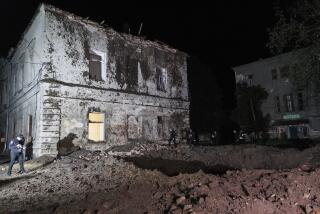
Russia attacks Ukrainian psychiatric hospital, energy facilities; Kyiv launches drones at Russia
April 27, 2024

U.S. announces new Patriot missiles for Ukraine as part of $6-billion aid package

Ukrainian drone attacks spark fires at Russian power stations, Moscow says
April 20, 2024
Start your day right
Sign up for Essential California for news, features and recommendations from the L.A. Times and beyond in your inbox six days a week.
You may occasionally receive promotional content from the Los Angeles Times.
More From the Los Angeles Times
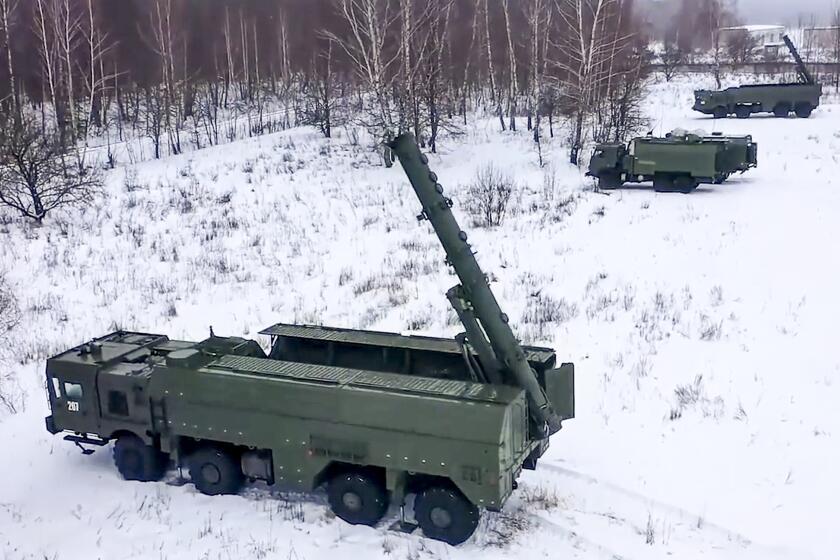
News analysis: Why Putin is raising the specter of nuclear weapons again

Ukraine marks its third Easter at war, coming under fire from Russian drones and troops
May 5, 2024

Russia puts Ukrainian President Zelensky on its wanted list
May 4, 2024

Drone footage shows Ukrainian village battered to ruins as residents flee Russian advance

IMAGES
VIDEO
COMMENTS
Ballistic missiles are different than cruise missiles. Cruise missiles are self-propelled for the majority of their time in the air, flying in a relatively straight line and at lower altitudes thanks to a rocket propellant. Think of a ballistic missile's flight path as a large arc up and back down again, while that of a cruise missile — fired from a warship, for instance — is closer to a ...
Ballistic missiles have three stages of flight: Boost Phase begins at launch and lasts until the rocket engine (s) stops firing and the missile begins unpowered flight. Depending on the missile, boost phase can last three to five minutes. Most of this phase takes place in the atmosphere. Midcourse Phase begins after the rocket (s) stops firing.
A BGM-109 Tomahawk flying in November 2002. A cruise missile is an unmanned self-propelled guided vehicle that sustains flight through aerodynamic lift for most of its flight path and whose primary mission is to place an ordnance or special payload on a target. Cruise missiles are designed to deliver a large warhead over long distances with high precision.
Cruise missiles are capable of being launched from multiple ground, air, sea and submarine platforms. Both fighter and long-range bomber aircraft are capable of carrying and launching cruise missiles. [5] On the ground, cruise missiles are most commonly launched by road-mobile systems due to the inherent advantages of mobility, but they can ...
They can be launched from ground, airplane, and sea platforms like submarines and surface warships. They tend to have shorter ranges than ballistic missiles. Unlike ballistic missiles, cruise missiles are usually categorized by intended missions and launch mode instead of maximum range. The two broadest categories are land attack cruise ...
The Biden administration released its unclassified Missile Defense Review today, as part of the National Defense Strategy. As policy guidance to an increasingly broad enterprise, the 2022 MDR represents an opportunity to achieve greater alignment between U.S. air and missile defense (AMD) efforts and the strategic competition with China and ...
The air-launched cruise missile (ALCM) had a length of 6.3 m (20.7 feet); it attained a range of 2,500 km (1,500 miles). It was designed for deployment on the B-52 bomber. The Tomahawk sea-launched cruise missile (SLCM) and the Tomahawk ground-launched cruise missile (GLCM) had a length of 6.4 m (21 feet), a diameter of 53 cm (21 inches), and a ...
used land-attack cruise missiles for the first time during the conflict in Syria. The US Armed Forces are responsible for countering the ballistic and cruise missile threat through deterrence, and if necessary active suppression. Threat suppression may include attacks on missile systems, both before launch and during flight, and attacks on their
4 Guided cruise and ballistic missiles were first used when Germany attacked targets in England and Northern Europe with V-1 cruise missiles and V-2 ballistic missiles during World War II.
BrahMos is technically a ramjetpowered supersonic cruise missile with a solid propellant booster that can be launched from land-based canisters, submarines, ships and now aircraft. It travels at speeds of Mach 2.8 to 3.0 but is being upgraded in the future to travel at speeds faster than Mach 5.0. for the hypersonic variant.
The Russian Navy has been planning to upgrade 3M14 "Kalibr" cruise missile with a longer-range "Kalibr-M" variant with a maximum firing range of more than 4,500 km. Rendering of Kalibr 3M14. The Tomahawk (Land Attack Missile (TLAM) is a long-range, all-weather, subsonic cruise missile primarily used by the United States Navy and Royal Navy.
Shooting missiles at other missiles is a hard problem because an incoming threat arrives at great speed, and because the cost calculus can favor an attacker. Interceptors, like shorter-ranged ...
Torpedo tubes. Surface ships. Submarines. TELs. The Tomahawk ( / ˈtɒməhɔːk /) Land Attack Missile ( TLAM) is a long-range, all-weather, jet-powered, subsonic cruise missile that is primarily used by the United States Navy and Royal Navy in ship and submarine-based land-attack operations. Developed at the Applied Physics Laboratory of Johns ...
Since the 1980s, the United States has invested considerable resources to develop and field ballistic missile defenses to protect the U.S. homeland from attack by long-range ballistic missiles. In recent years, concerns have arisen that another type of weapon—land-attack cruise missiles (LACMs)— may also pose a threat to the U.S. homeland.
Since the 1990s, the United States has relied on Tomahawk cruise missiles launched from their warships and submarines. The missile, with a flight capability. ... missiles have a range of 1000-1500 kilometers and use INS GPS and digital scene matching area correlation Dsmac to compare onboard camera images with recorded ones.
The Kalibr suite was designed to compare favorably with Washington's prolific but aging Tomahawk cruise missiles. Whereas the original Kalibr 3M14 traded per...
Cruise Missiles versus Unmanned Aircraft. In general, making the distinction between ordnance and UA is not useful, due to tremendous technical progress. These two categories are not exclusive anymore, while not every ordnance is a UA, a UA can be used as ordnance. In times of mass production, innovative propulsion systems and reliable effect ...
keep the missile on a pre-programmed flight path. As advanced cruise missiles approach their target, remote operators can use a camera in the nose of the missile to see what the missile sees. This gives them the option to manually guide the missile to its target or to abort the strike. To learn about missile defense, check out our fact sheet ...
The following is a list of cruise missiles. It doesn't include the specifically anti-ship missiles whose list is separate. Missile Type Country Max. range Max. Speed (Mach) Mass Warhead Warhead type Status Note AV-TM 300: Surface-to-surface missile
The Taurus cruise missiles, fired by fighter jets, are roughly the same length and weight as the UK's Storm Shadow and France's Scalp-EG. What really sets the German missile apart is its ...
The 3M-54 Kalibr was developed by the Novator Design Bureau in 1994 as a counter to the American Tomahawk cruise missile and has been under production in various forms ever since. The current war between Russia and Ukraine has seen a wide variety of sophistication in the weaponry on both sides. Although the Russians seem to have enjoyed the ...
North Korea said Saturday it tested a "super-large" cruise missile warhead and a new anti-aircraft missile in a western coastal area as it expands military capabilities in the face of deepening tensions with the United States and South Korea. (AP Photo/Ahn Young-joon)
The largest difference between cruise missiles and TBM's is speed. Edit: and range. TMB's top out at a few hundred miles before they start to have strategic implications, while cruise missiles can go over a thousand miles. Cruise missiles are basically unmanned aircraft, most of which are powered by small jet engines.
The recent missile tests are part of a broader series of weapons demonstrations that include last week's unveiling of a new cruise missile, Pulhwasal-3-31, and the test-firing of the country's ...
TERCOM. Terrain contour matching, or TERCOM, is a navigation system used primarily by cruise missiles. It uses a contour map of the terrain that is compared with measurements made during flight by an on-board radar altimeter. A TERCOM system considerably increases the accuracy of a missile compared with inertial navigation systems (INS).
The Russian Navy has approximately 270 Kalibr sea-launched cruise missiles, with a production rate of 30 to 40 units per month. Only 45 Kh-69 air-launched missiles remain in stock, with only three ...
By comparison, Iran's earlier ... It was also a huge flop, with an estimated 99% of the more than 320 drones, cruise missiles and ballistic missiles failing to hit their planned targets.
One is the USS Harry S Truman, a nuclear-powered aircraft carrier. That ship will be about three miles offshore so the Navy isn't offering public tours. But sailors from the Truman will participate in Fleet Week events. The Navy's three other ships: USS Bataan (LHD 5) - Amphibious Assault Ship. USS Leyte Gulf (CG 55) - Guided Missile ...
Comparison of anti-ballistic missile systems. This is a table of the most widespread or notable anti-ballistic missile ( ABM) systems intended in whole or part to counter ballistic missiles. Since many systems have developed in stages or have many iterations or upgrades, only the most notable versions are described.
The Associated Press on Thursday visited a plant owned by DTEK, the country's biggest private energy supplier, days after a cruise-missile attack left it a mess of smashed glass, shattered ...